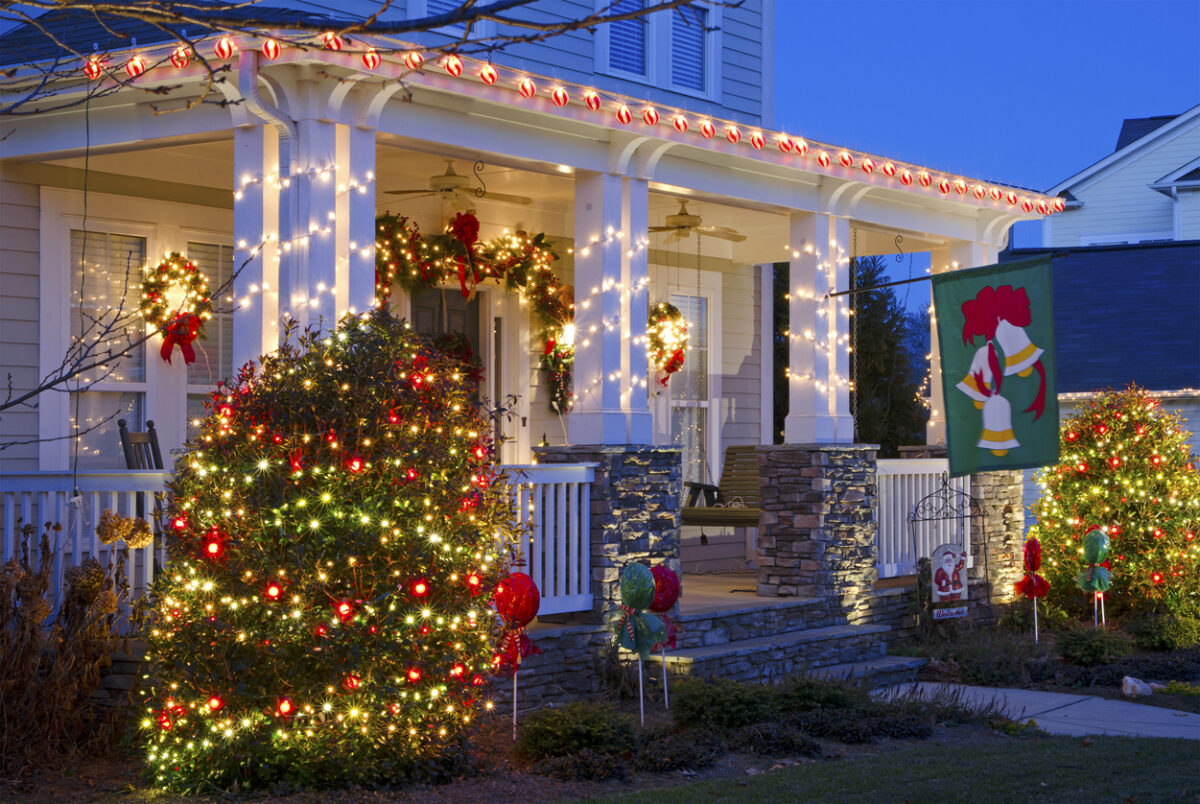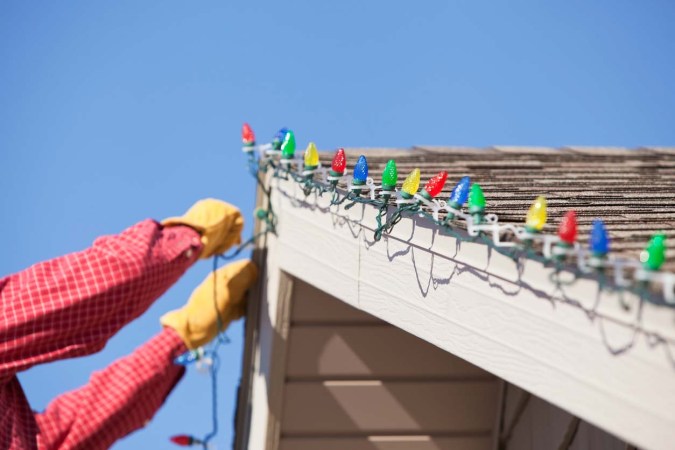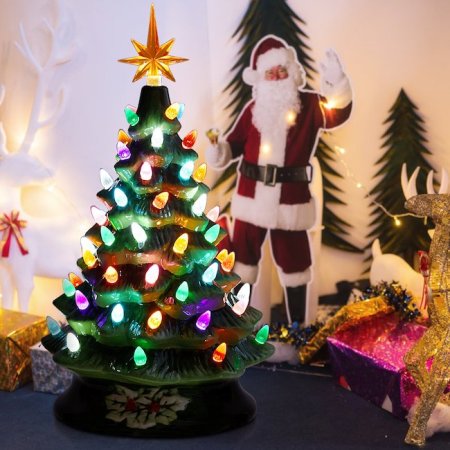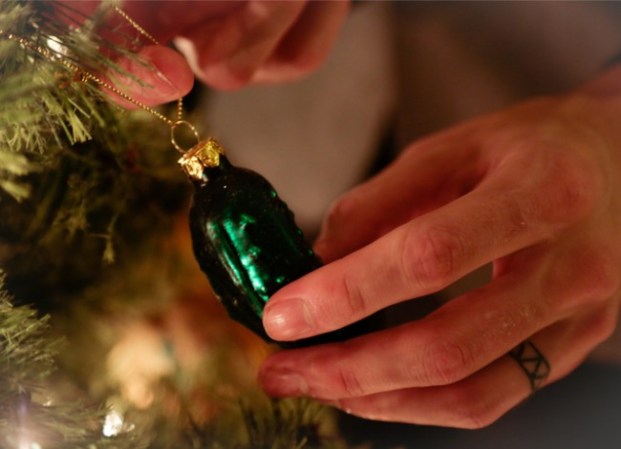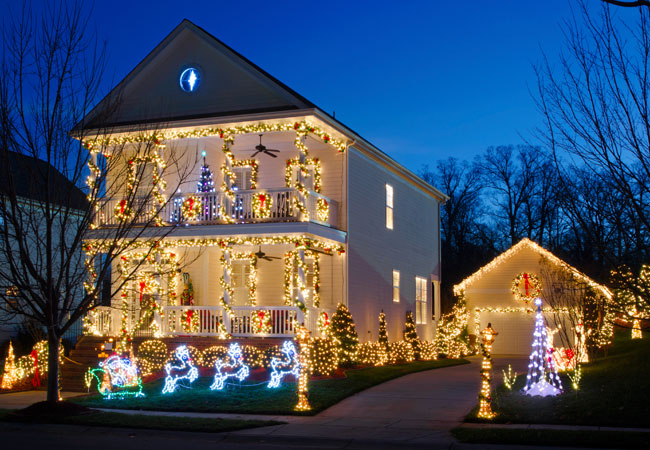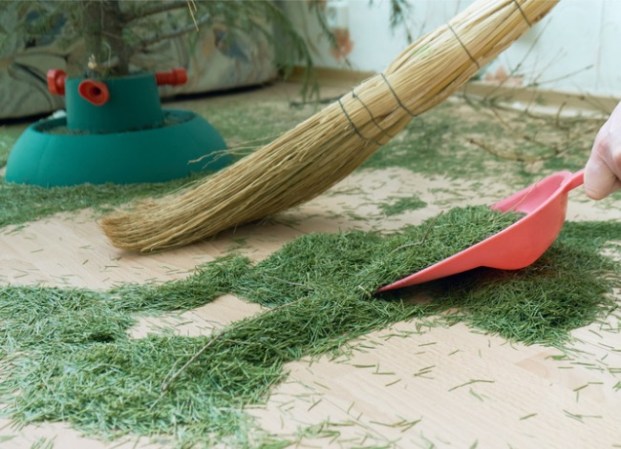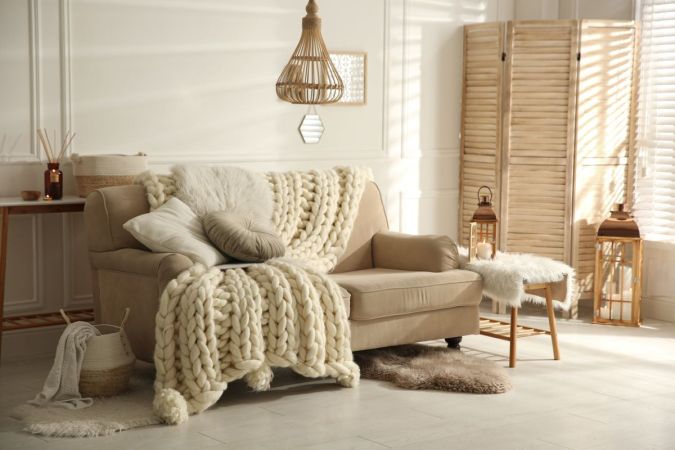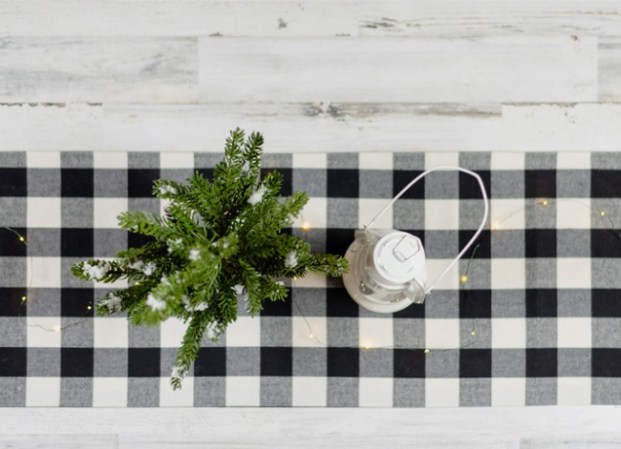We may earn revenue from the products available on this page and participate in affiliate programs. Learn More ›
As the winter holiday season approaches each year, homeowners once again begin planning their Christmas light displays. Whether this is your first year hanging holiday lights or you’re ready to upgrade last year’s decorations, it can still be overwhelming to see how many types of Christmas lights are on the market—let alone trying to decipher which are the best Christmas lights for your home.
Read on to learn more about each of the different types of Christmas lights most widely available in stores and online. Knowing your options when it comes to power sources, bulb types, sizes, and colors can help turn your festive vision into reality.
Indoor vs. Outdoor Christmas Lights
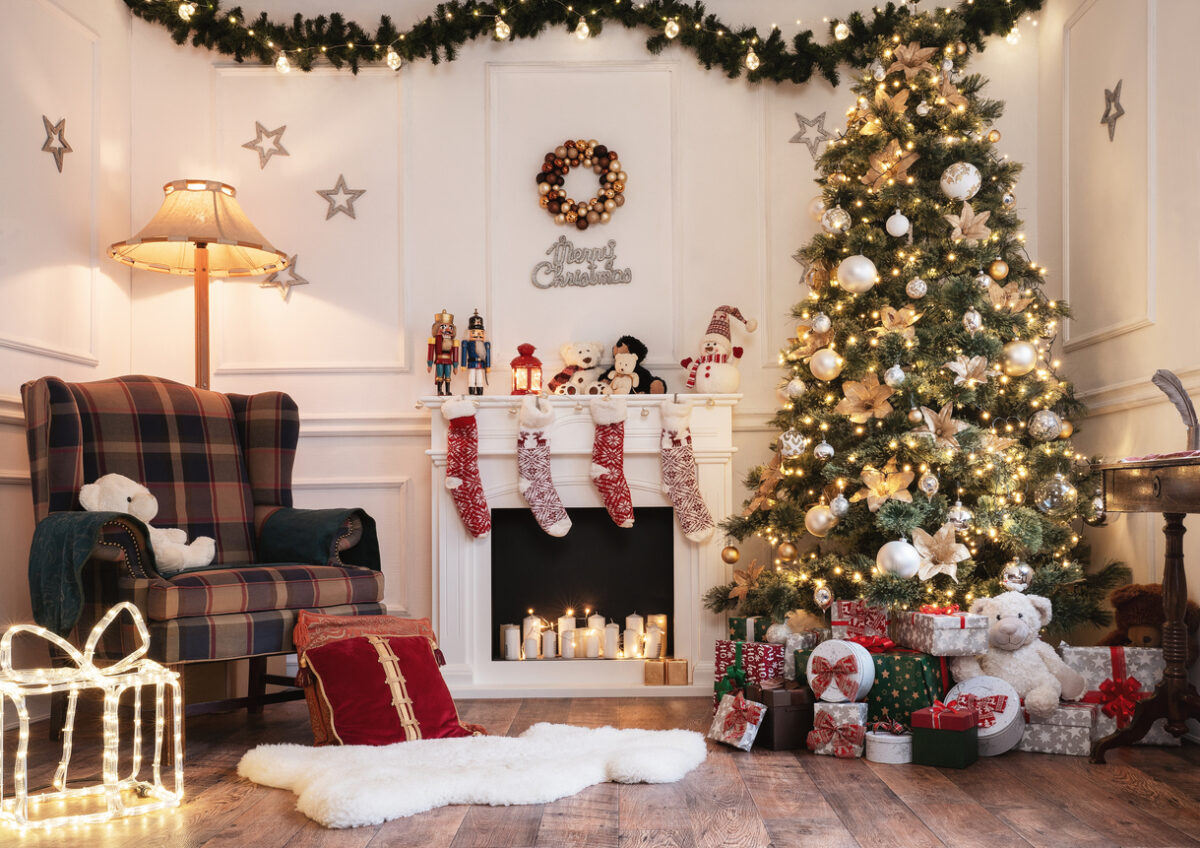
Holiday lights can illuminate and bring cheer to indoor and outdoor spaces alike. However, many lights are labeled for either indoor or outdoor use. While most outdoor Christmas lights can also be used inside, lights labeled for indoor use should not be used outside.
Indoor Christmas lights are tested to ensure they don’t pose a fire risk, but they aren’t as durable as outdoor lights. They also aren’t designed to get wet or endure cold weather conditions. Some of the most popular types of indoor Christmas lights used to light your Christmas tree, mantle, railings, and other areas of your home include (but are not limited to) the following:
- Fairy lights
- Lighted garland
- Lighted Christmas trees
- Lighted Christmas tree stars
If you’ve lost your lights’ original boxes or mixed up different strands of lights since storing them, check the tag to determine whether they are meant for indoor or outdoor use. Outdoor Christmas lights should feature a red or silver tag with red writing, while indoor lights will have a green or a silver tag with green writing.
Regardless of whether you’re using indoor or outdoor Christmas lights, it’s important to make sure that they are UL listed. This classification indicates that the lights have undergone testing to ensure they are safe against fire and shock.
RELATED: Don’t Throw Your Dead Holiday Lights in the Trash—Do This Instead
Types of Christmas Light Power Sources
Christmas lights can be powered by electricity, batteries, or solar energy. The demands and preferences of your setup and budget can help you determine which types of power are right for you.
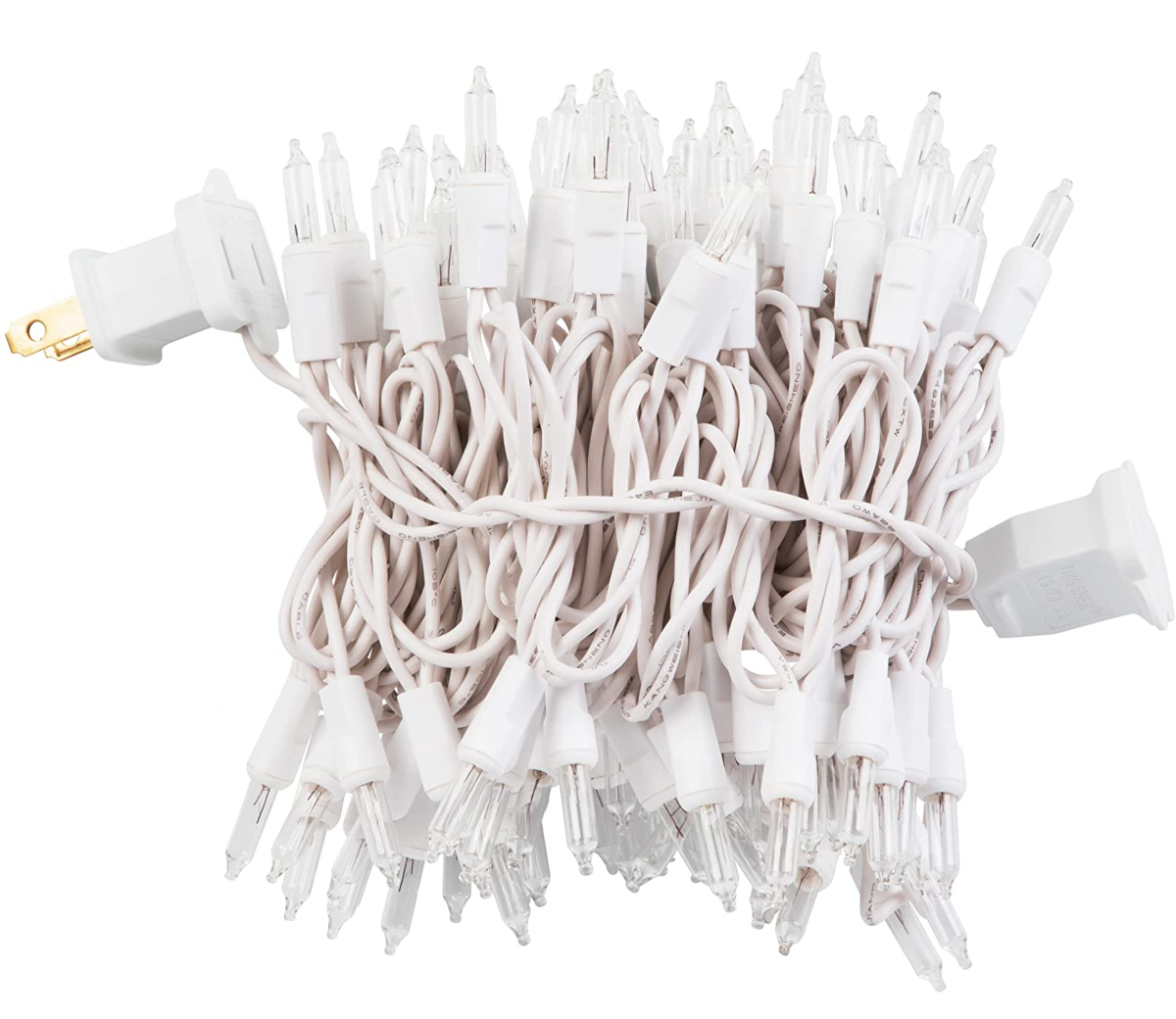
1. Plug-In
Plug-in lights are likely what comes to your mind when you think about Christmas lights. This type of light may conjure up memories of looking for a burned-out bulb along a long light string when fixing Christmas lights.
Plug-in Christmas lights are powered by electricity, so you will need a nearby power source or outdoor-rated extension cord to use them. A benefit of plug-in lights is that you won’t need to worry about dead batteries or the solar charge depleting. However, plug-in lights will not work in a power outage without a backup power source.
Best For: Reliable and lasting holiday light displays near available power outlets.
Our Recommendation: Prextex 100-Count White Christmas Lights on Amazon for $9.99
These plug-in string lights include 100 warm white lights with a waterproof design suitable for indoor or outdoor use.
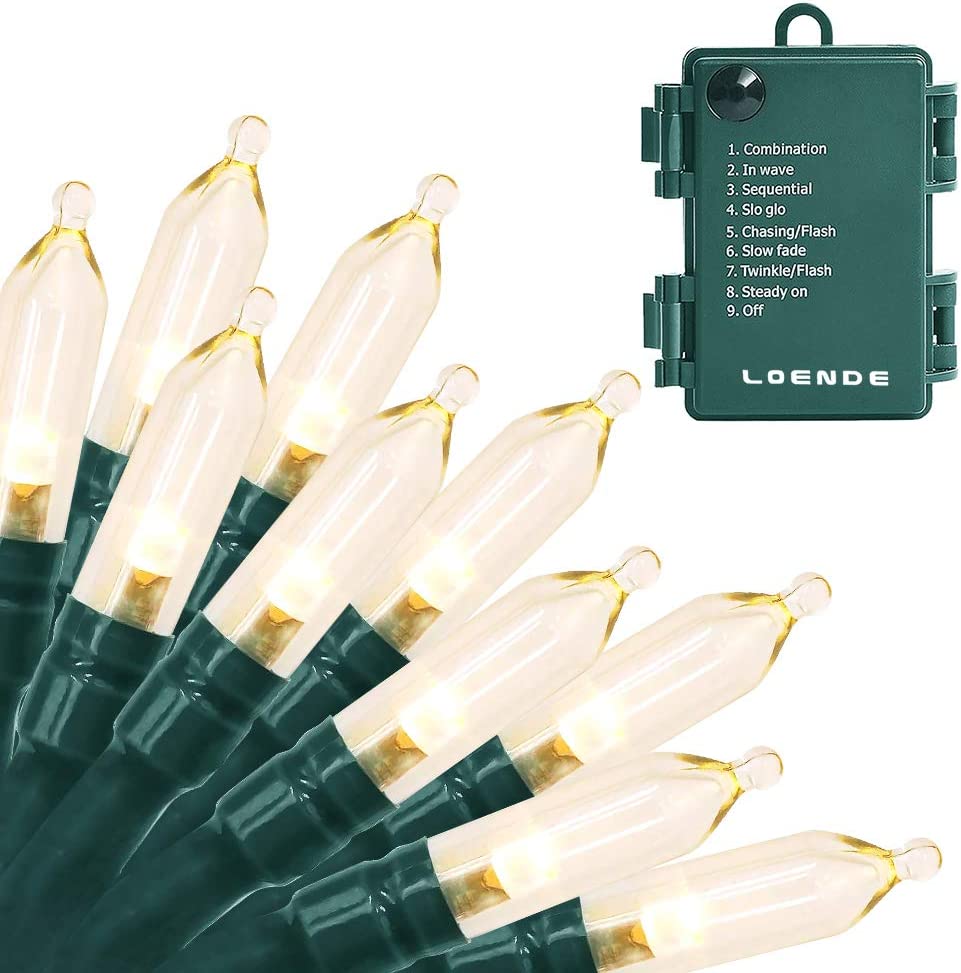
2. Battery-Powered
If you’re planning a light display in a spot electrical outlets can’t reach, consider using battery-operated Christmas lights. Battery-powered lights are also a good solution for areas where cords could pose a tripping hazard or when you want to keep the power source hidden, such as when lighting a Christmas wreath on an entry door.
The lifespan of battery-operated lights can vary based on the number of lights on the strand, whether the bulbs are LED or incandescent, battery quality, and other factors. While some products can stay lit for more than 100 hours before requiring new batteries, others may require fresh batteries after only a few hours.
Best For: Spots where no power outlets are available or when no cords are desired.
Our Recommendation: Loende Battery-Operated String Lights on Amazon for $13.98
Maintaining a classic string light look in white, red, blue, orange, or multicolor, these indoor lights feature eight modes and an automatic power timer.
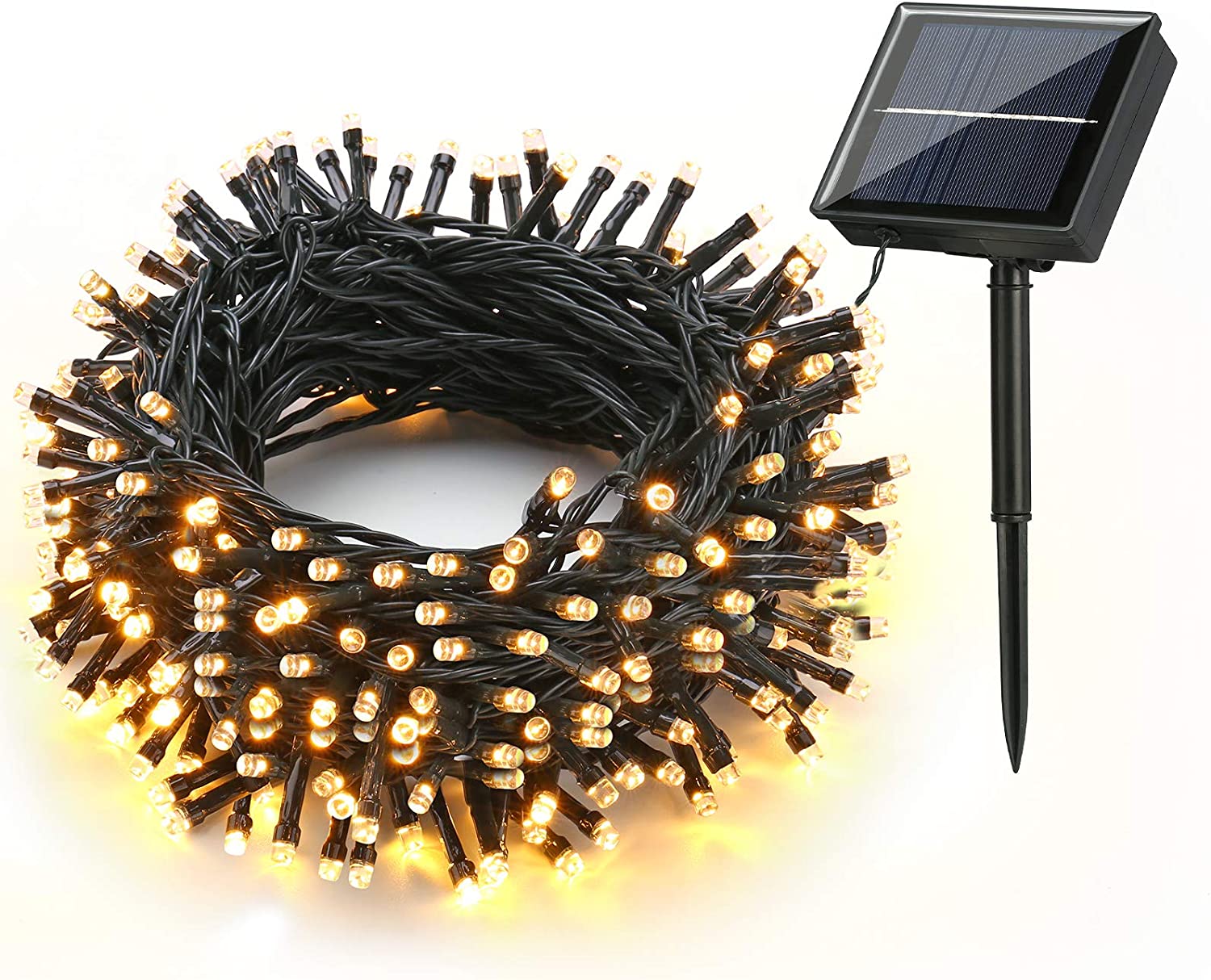
3. Solar-Powered
Solar-powered Christmas lights offer a more eco-friendly solution for holiday decorations. Rather than consuming electricity, these lights are powered by sunlight through a connected solar panel. Solar Christmas lights are usually priced comparably (or even less expensive) than their plug-in counterparts.
However, if the included solar panel is placed in the shade or doesn’t receive enough sun on a cloudy day, the lights may not remain lit as long later that night. If you’re planning a large display, the individual solar panels of each light strand could potentially leave your lawn cluttered.
Best For: Small areas that get a lot of sunlight.
Our Recommendation: Joomer Solar String Lights on Amazon for $18.68
These solar-powered lights include 300 multicolor LED bulbs with eight modes, and a 6-hour charge during the day will power the lights for a full night.
Christmas Light Bulb Types
The two most common Christmas light bulb types are LED and incandescent. Each type of bulb offers its own pros and cons, and determining which one is best for your holiday decorations comes down to preference and cost.
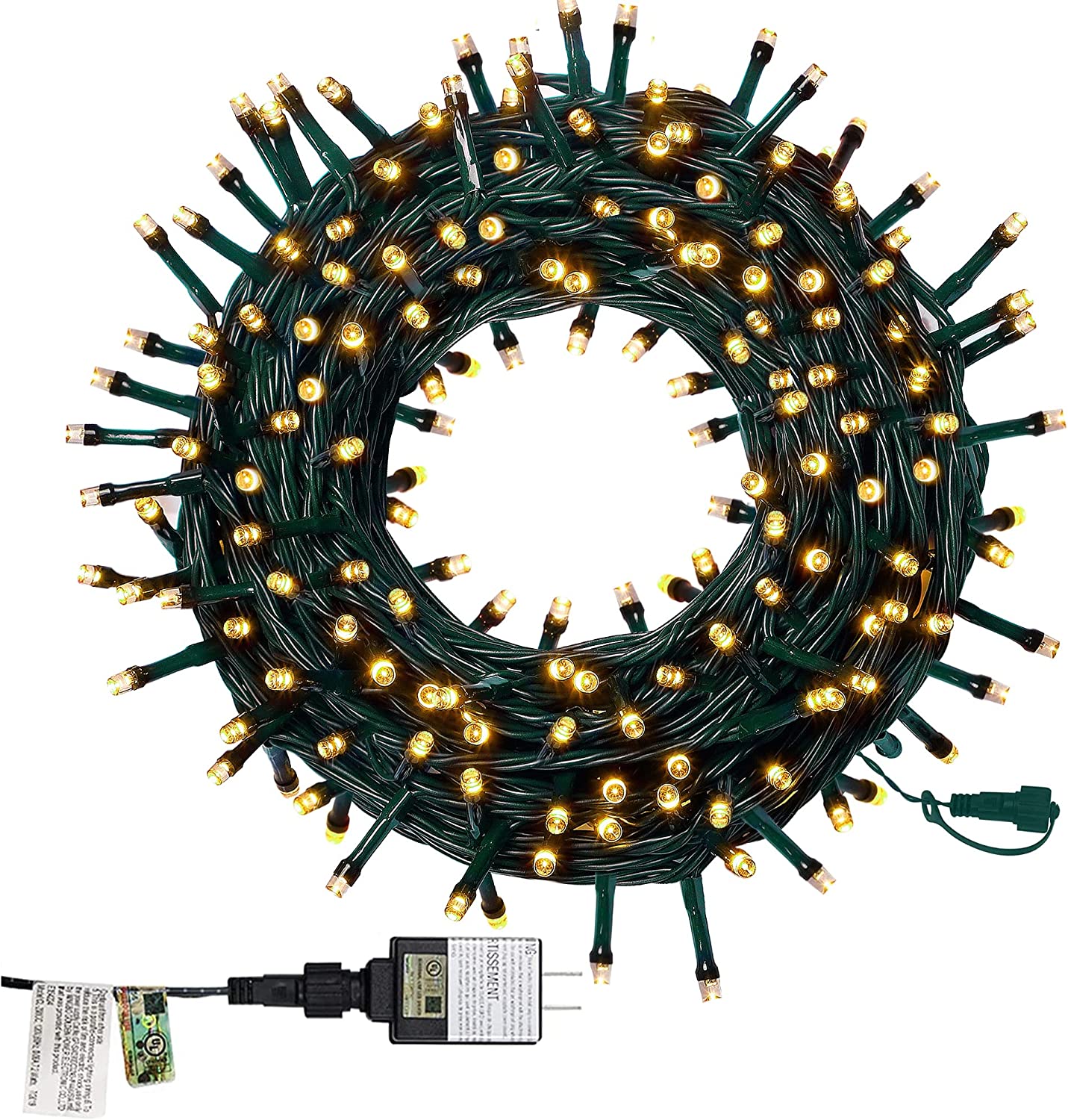
1. LED
LED Christmas lights are far more energy-efficient than traditional incandescent bulbs. LED bulbs also last significantly longer than incandescent bulbs, with some lasting for up to 100,000 hours. Additionally, LED bulbs are brighter and stay cooler than incandescent bulbs when lit.
LED Christmas lights are more expensive than incandescent lights, so be prepared for a higher initial investment when creating a new display. However, they’re likely to pay for themselves since you won’t need to purchase new lights as frequently.
Best For: Efficient, long-lasting, and vibrant holiday displays.
Our Recommendation: Twinkle Star LED Decorative Fairy Mini String Lights on Amazon for $15.99
These UL-certified, commercial-grade LED fairy lights extend to a length of 66 feet, come in various colors, and offer eight lighting modes.
2. Incandescent
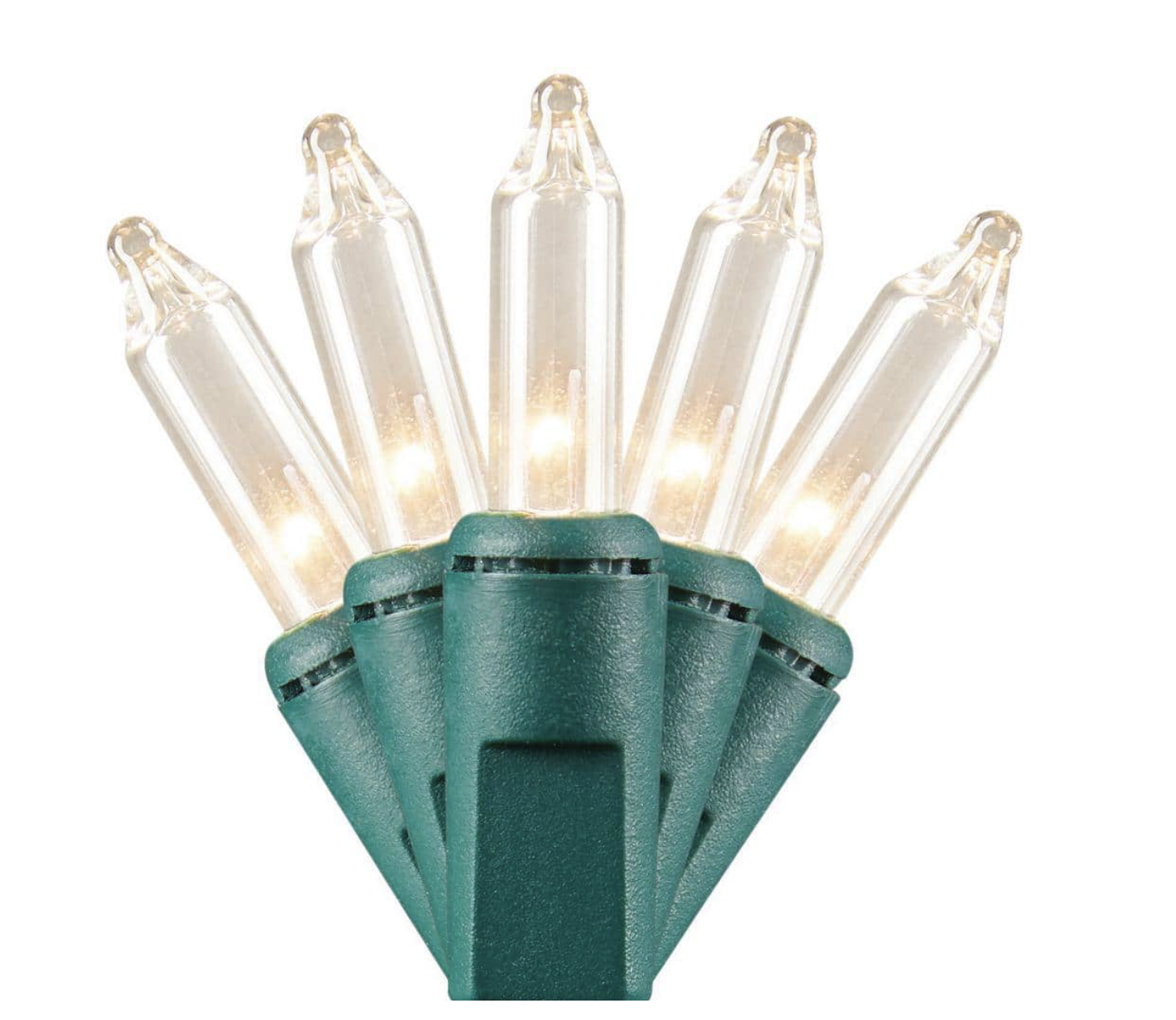
Incandescent lights are typically less expensive than LEDs. They give off a warmer glow, which some may prefer over the brighter light that LEDs produce.
However, incandescent bulbs burn out faster, are less durable, and cost more to operate than LED bulbs. They also become hotter to the touch when lit.
Best For: Traditional displays where warmer, dimmer lights are desired.
Our Recommendation: Home Accents Holiday 300L Incandescent Mini Lights at The Home Depot for $12.98
Even if a bulb burns out, this strand of 300 mini multicolor incandescent lights will remain lit.
Christmas Light Bulb Sizes
In addition to deciding on your desired power source and bulb type, think about the bulb size(s) that will best suit your purposes and overall design scheme.
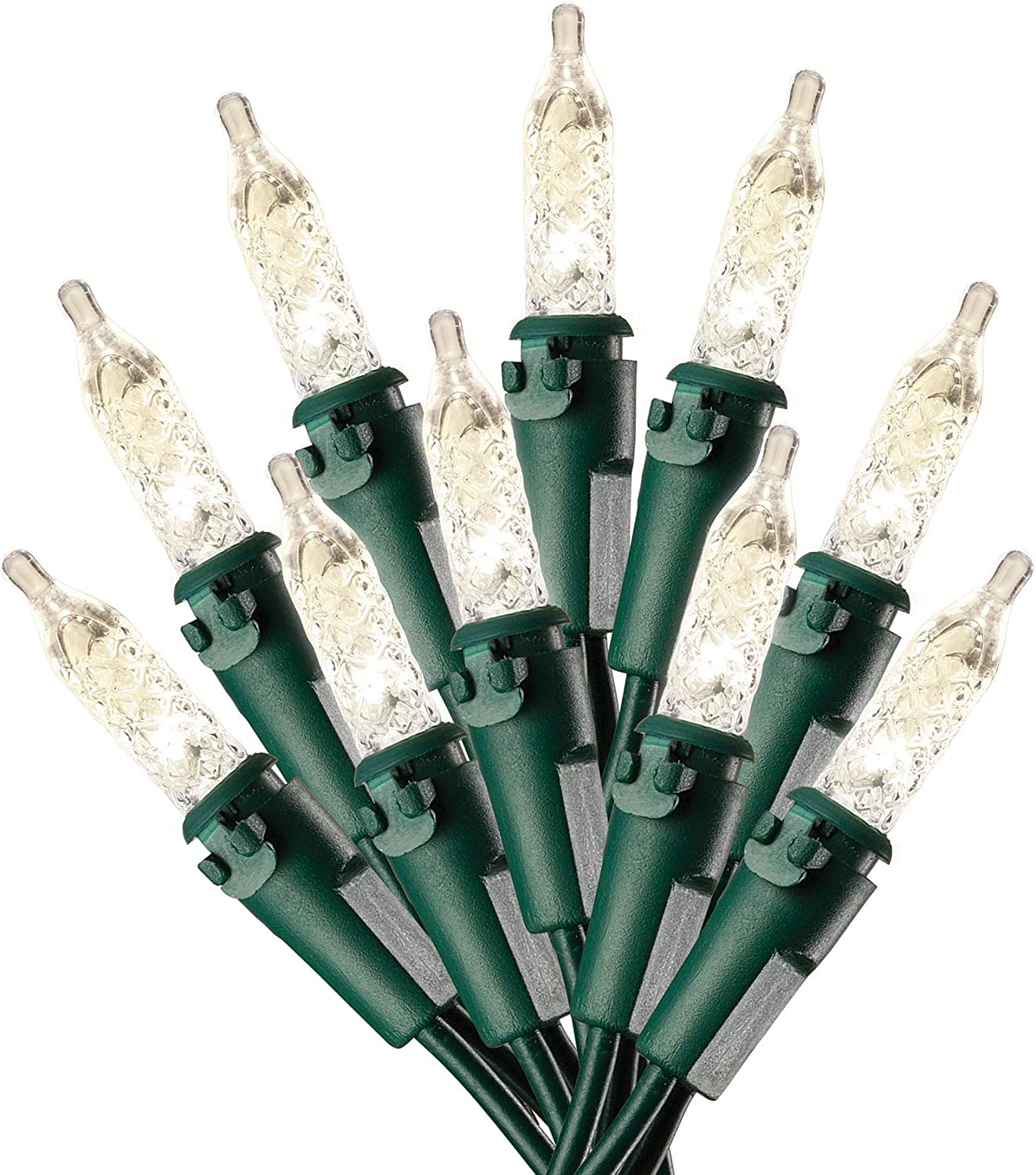
1. Mini Lights
Mini lights are among the most popular Christmas light bulb sizes. While mini lights typically have LED bulbs, they often closely mirror traditional incandescent mini light bulb design. Mini lights are ideal for decorating Christmas trees, wrapping around bushes or columns, or lining the roof of a home.
There are two main types of mini lights: M5 bulbs and T5 bulbs. Both share a similar overall shape, but T5 bulbs more closely match the design of incandescent bulbs with their pointier tips. M5 bulbs have a slightly more rounded tip and textured sides.
Best For: Decorating Christmas trees and lining a home’s architectural features.
Our Recommendation: Sylvania 100 LED Mini Lights Warm White on Amazon for $10.99
Give a warm white glow to your Christmas tree, bushes, columns, and more with this set of 100 T5 mini lights from Sylvania.
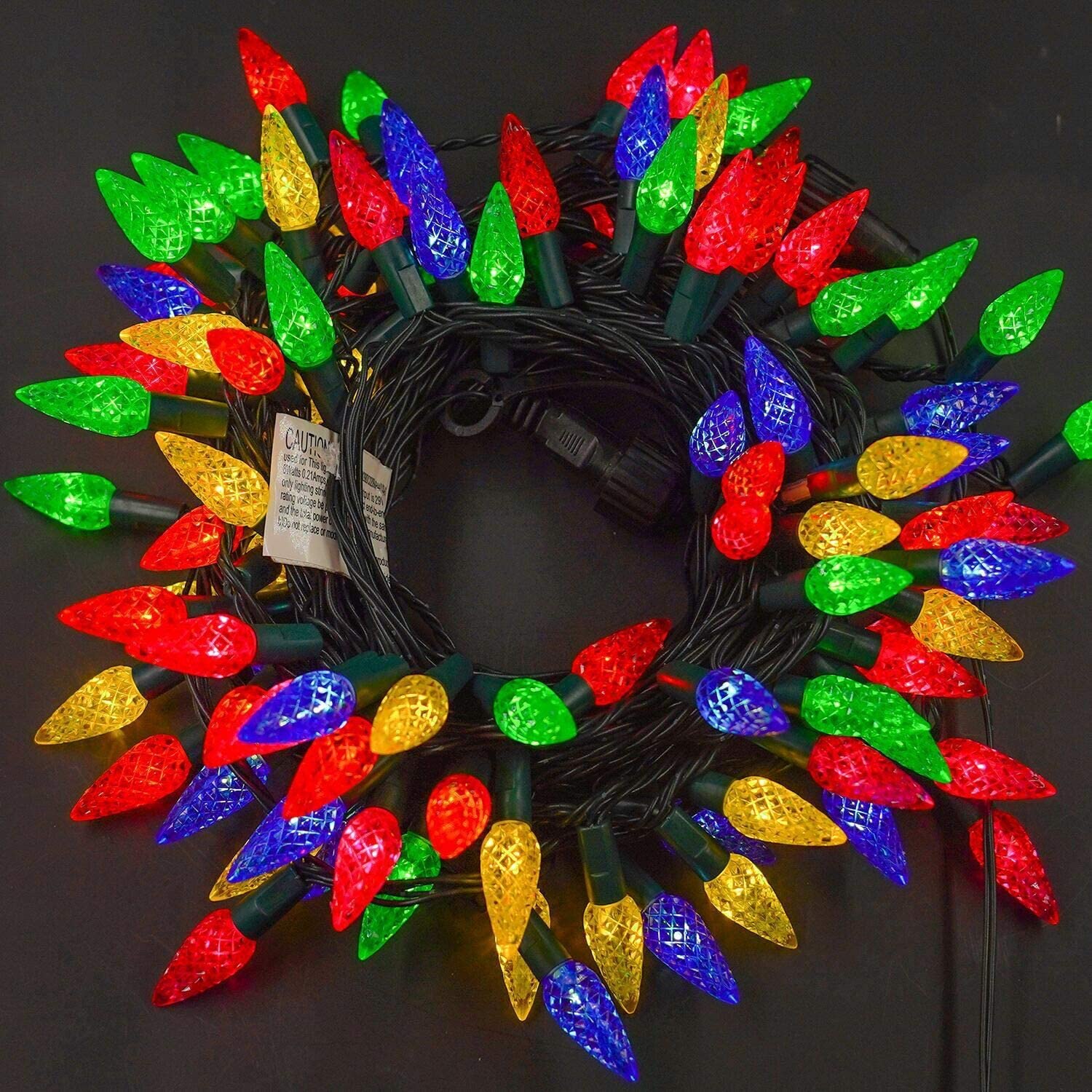
2. C6
The shape of a C6 bulb is what many think of when they picture a traditional Christmas bulb. These lights—the smallest in the series with this traditional shape—resemble the shape of a strawberry. The C stands for cone size, and most C6 bulbs are approximately ¾ inch in diameter and about 1⅛ inches tall.
Best For: Lighting smaller landscaping features.
Our Recommendation: Twinkle Star C6 Christmas String Lights on Amazon for $19.99
This set of C6 Christmas lights includes 100 multicolor LED bulbs, eight lighting modes, and end-to-end plugs allowing up to four sets to be linked together.
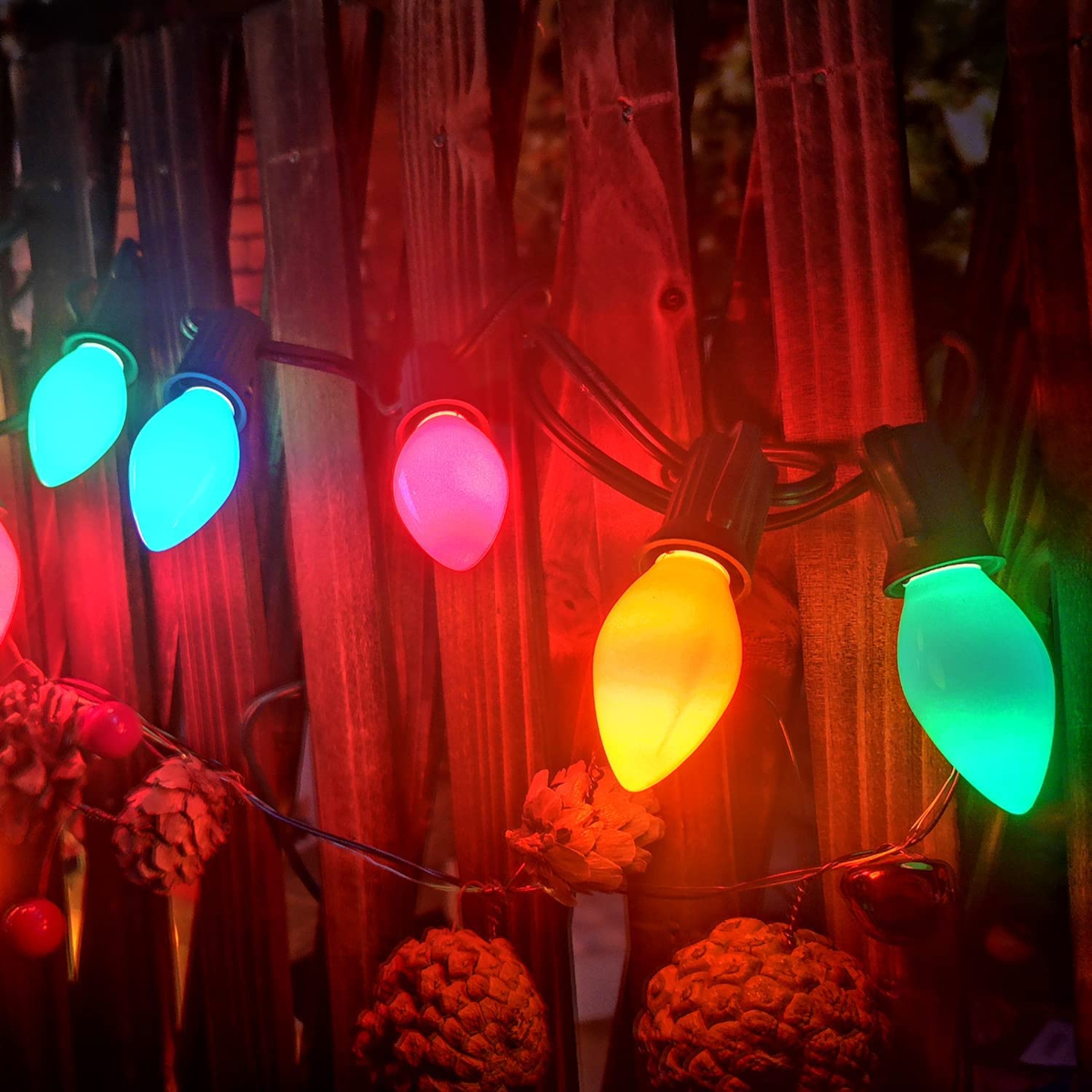
3. C7
C7 Christmas lights share the same strawberry shape as C6 bulbs but are slightly larger. C7 bulbs have a diameter of about 1 inch and are about 1½ inches tall, making them look a bit rounder than C6 bulbs.
Best For: Wrapping large shrubs and bushes.
Our Recommendation: Couah C7 Christmas String Lights on Amazon for $18.99
This 25-foot string of C7 lights offers 27 incandescent bulbs in a mix of red, green, blue, yellow, and green.
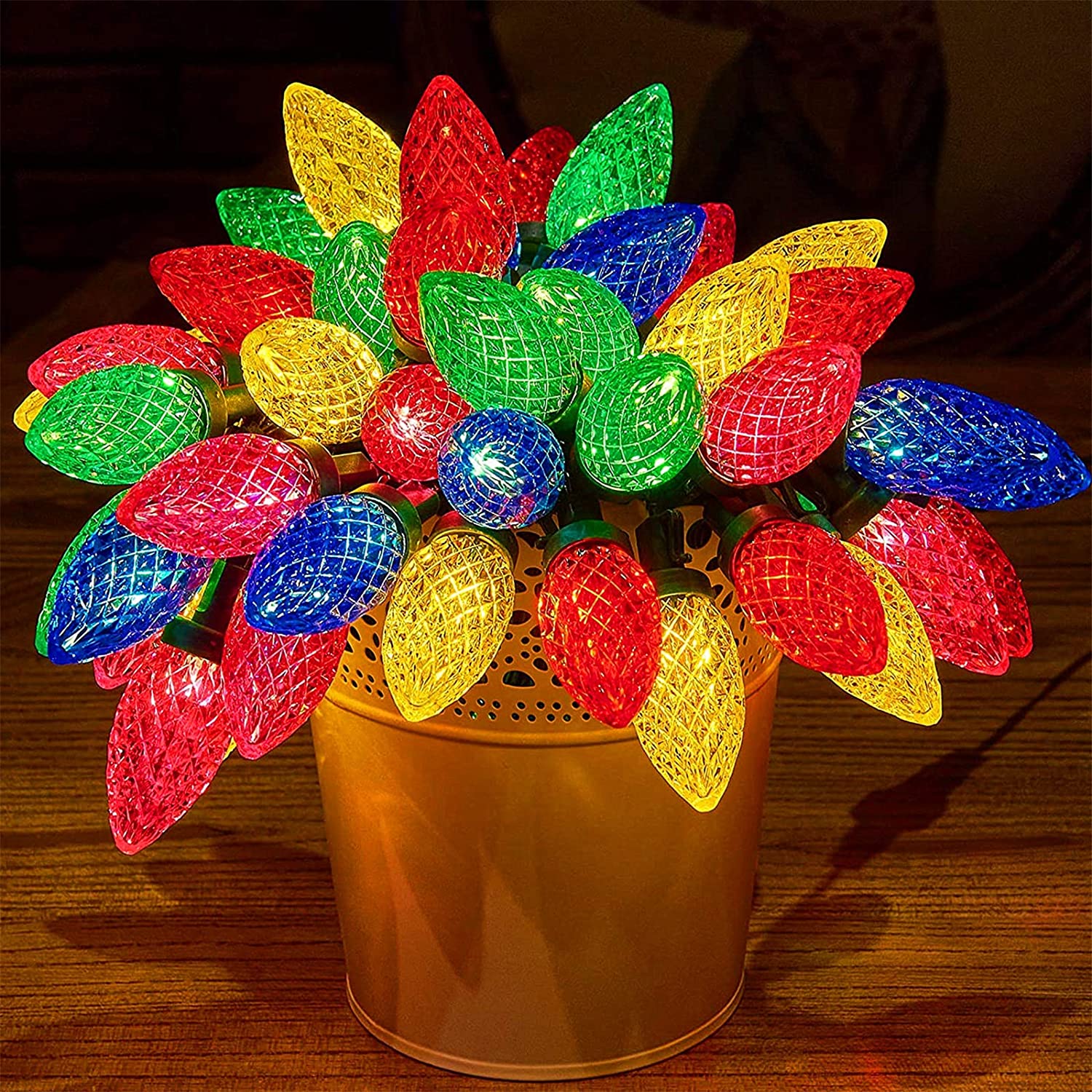
4. C9
C9 Christmas lights—the biggest in the C series—are the bulb of choice for many professionals. These bulbs have a 1¼-inch diameter and are 2½ inches tall. Their greater size and power (up to twice the wattage of C7 bulbs) makes them ideal for illuminating wide outdoor spaces, such as outlining a roof or wrapping large shrubs and trees.
Best For: Illuminating longer rooflines.
Our Recommendation: Twinkle Star C9 Christmas String Lights on Amazon for $26.99
This 49-foot string of C9 LED bulbs is expandable and can provide vibrant lighting for many outdoor holiday decor needs.
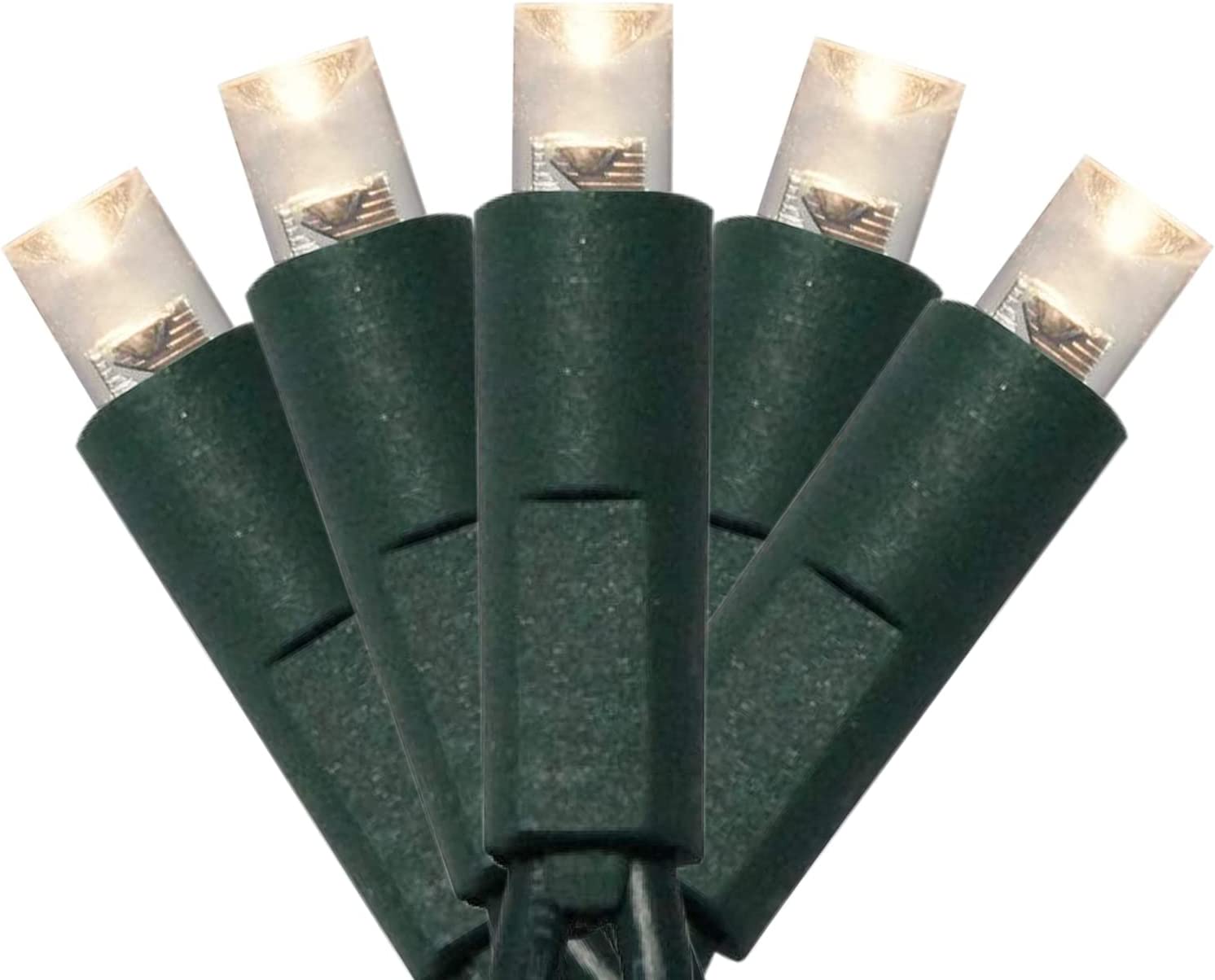
5. 5mm LED
Also called wide-angle lights, 5mm LED Christmas lights offer focused and bright light. Because of their smaller size, they don’t snag as easily, so 5mm lights are often the bulb of choice when wrapping tree trunks and branches. However, don’t let the small size of these conical bulbs fool you—these lights can easily illuminate large spaces.
Best For: Wrapping branches, bushes, or trees.
Our Recommendation: Everfit Lighting 5mm Wide Angle LED Christmas Lights Set on Amazon for $13.90
Featuring a 75,000-hour lifespan and one-piece construction, this string of 5mm LED lights can help keep your Christmas display illuminated for years to come.
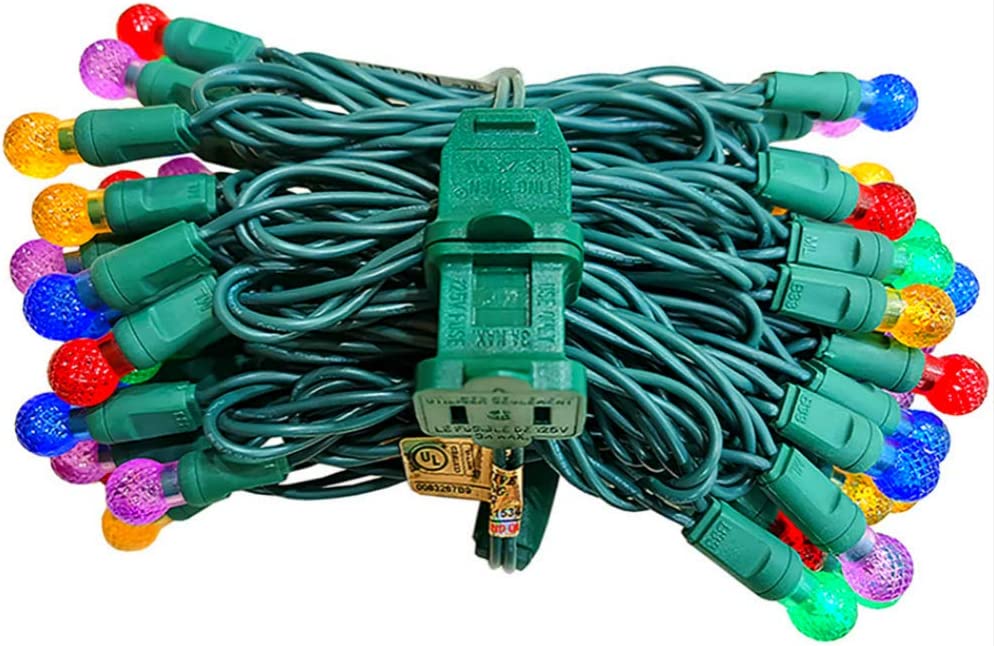
6. G12
G12 Christmas lights have a round globe shape. While there are a range of G-series bulb sizes, G12s are among the most popular. These bulbs are spherical with a ⁷⁄₁₆-inch diameter and a ½-inch height. The globe shape of these bulbs projects light in all directions to provide a beautiful halo effect. They can be used for a variety of decorating needs, such as lighting Christmas trees and wrapping banisters.
Best For: Creating a halo lighting effect.
Our Recommendation: Borita G12 Colored Outdoor Christmas Lights on Amazon for $23.99
These bright multicolor G12 Christmas lights are UL-certified, waterproof, and rated to last up to 10,000 hours.
Christmas Light Colors
Before buying your Christmas lights, first decide which colors will work best with your holiday display plans. From single-color lights in a range of hues to multicolor options, the following are some of the most popular Christmas light colors to consider.
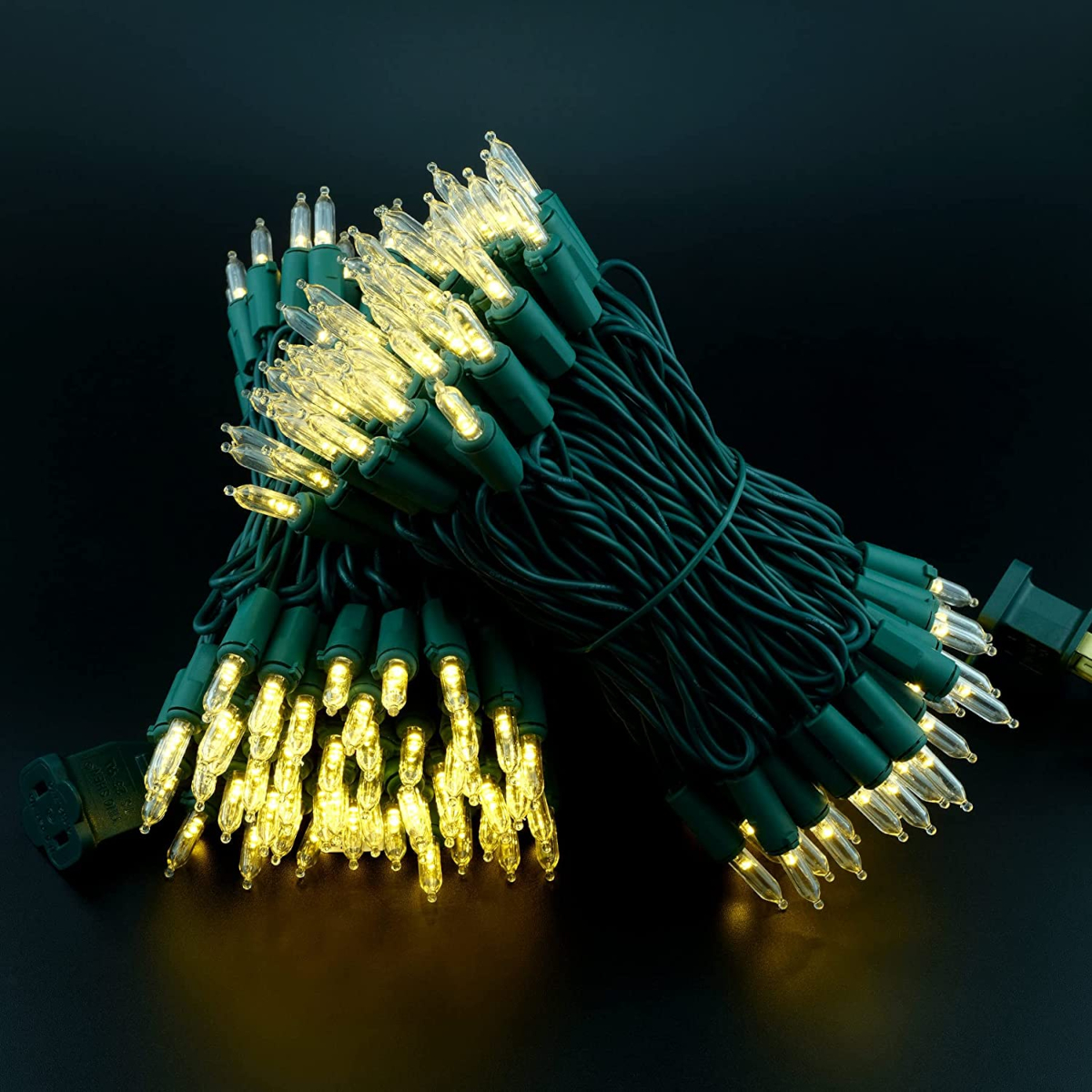
1. Warm White
White Christmas lights are often used to create a traditional look. Some prefer to use only white Christmas lights in their indoor and outdoor decorations, while others like the contrast of colorful bushes and trees against a home trimmed with white string or icicle lights.
Best For: Adding warmth to traditional holiday displays.
Our Recommendation: Yuletime Warm White LED Christmas Lights on Amazon for $33.99
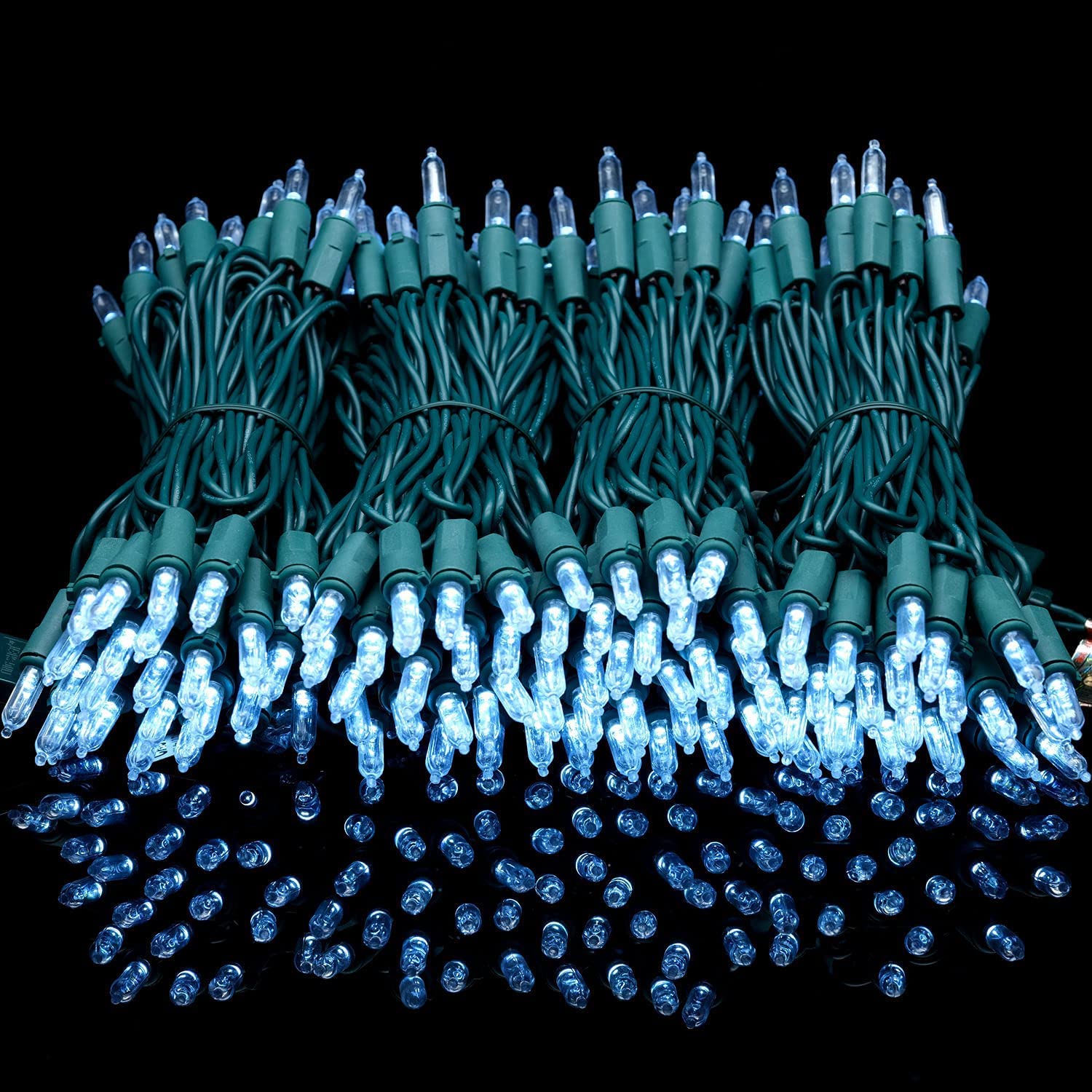
2. Cool White
Although most commonly used outdoors, cool white Christmas lights can also add a modern, fresh look to an indoor tree. This brilliant color has a more icy look than warm white lights, making it a popular choice for icicle lights and novelty seasonal bulb shapes.
Best For: Lighting up wintry outdoor light displays.
Our Recommendation: Yuletime Cool White LED Christmas Lights on Amazon for $33.99
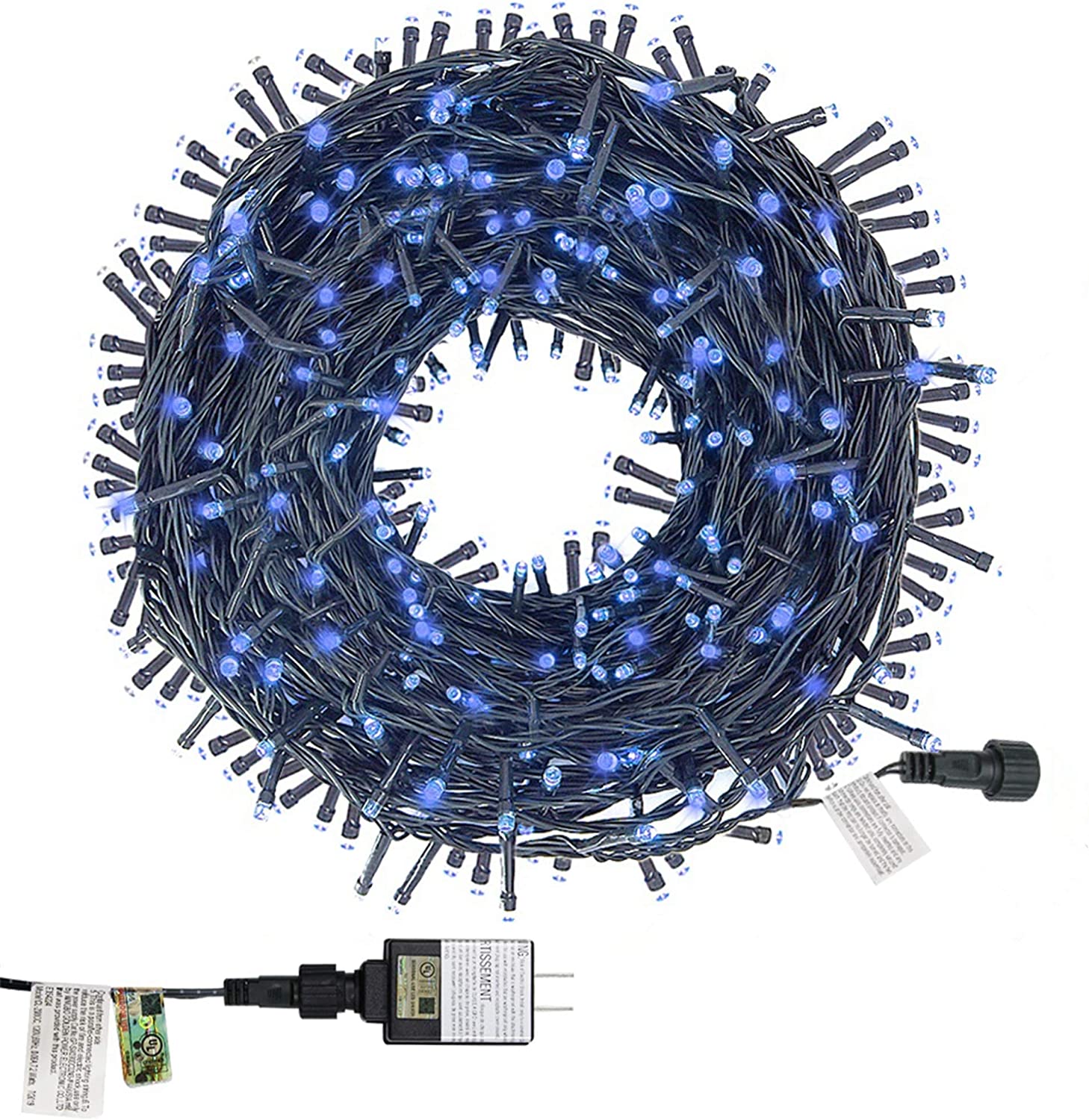
3. Blue
Blue Christmas lights can complete a winter wonderland look with their crisp, cool color. Blue lights are also ideal when decorating for Hanukkah, showing patriotism when paired with red and white lights, or honoring first responders and veterans.
Best For: Embracing a cool, bright winter holiday palette.
Our Recommendation: Twinkle Star Blue LED Christmas Tree String Lights on Amazon for $15.99
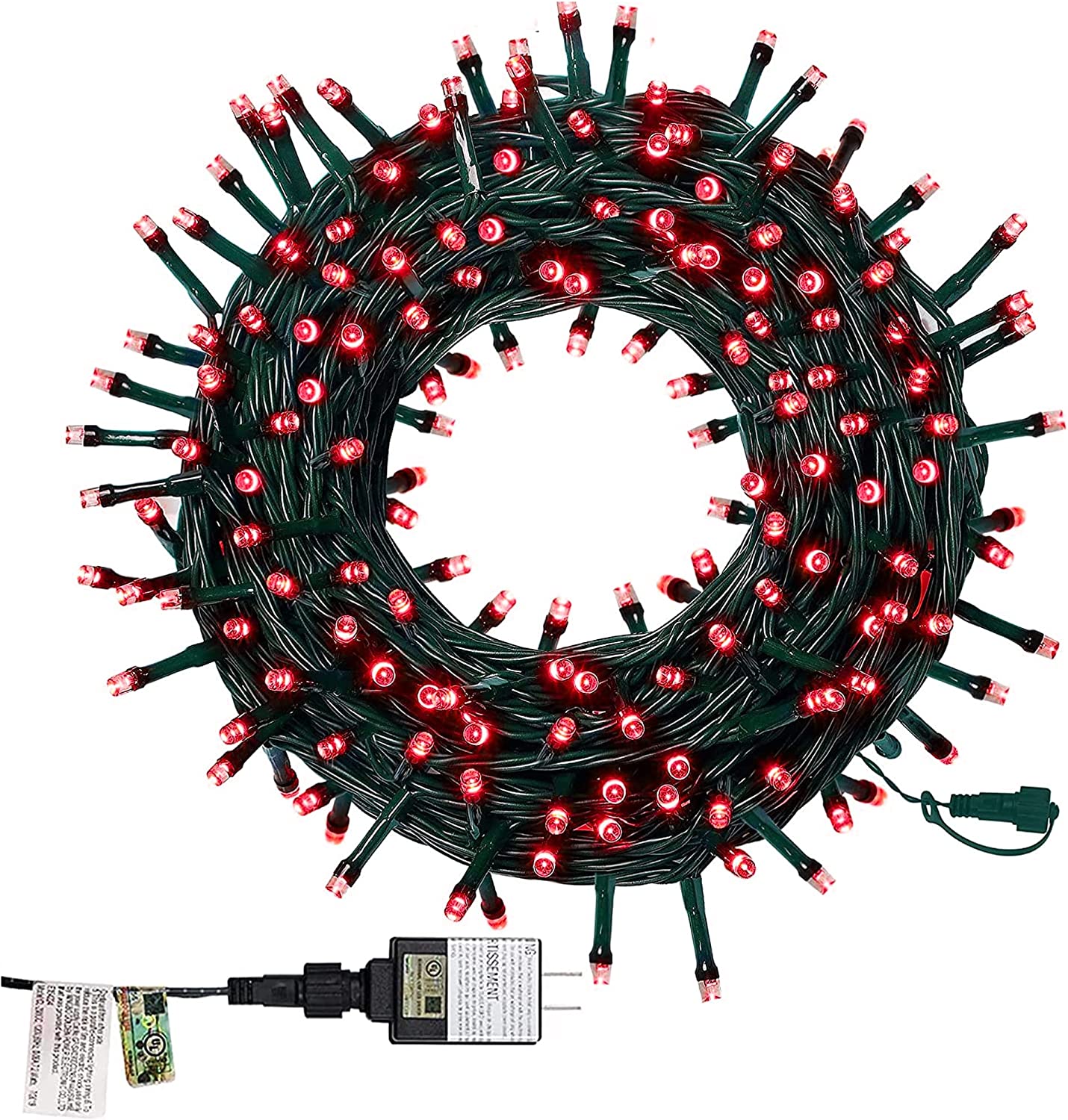
4. Red
Red is a color strongly associated with Christmas traditions. Many associate red Christmas lights with similarly colored holiday items, like poinsettias, holly berries, and Santa Claus. Using red lights to accentuate a display can draw more attention to your yard while being easy on the eyes.
Best For: Livening up a home with a traditional Christmas color.
Our Recommendation: Twinkle Star Red LED Christmas Tree String Lights on Amazon for $18.99
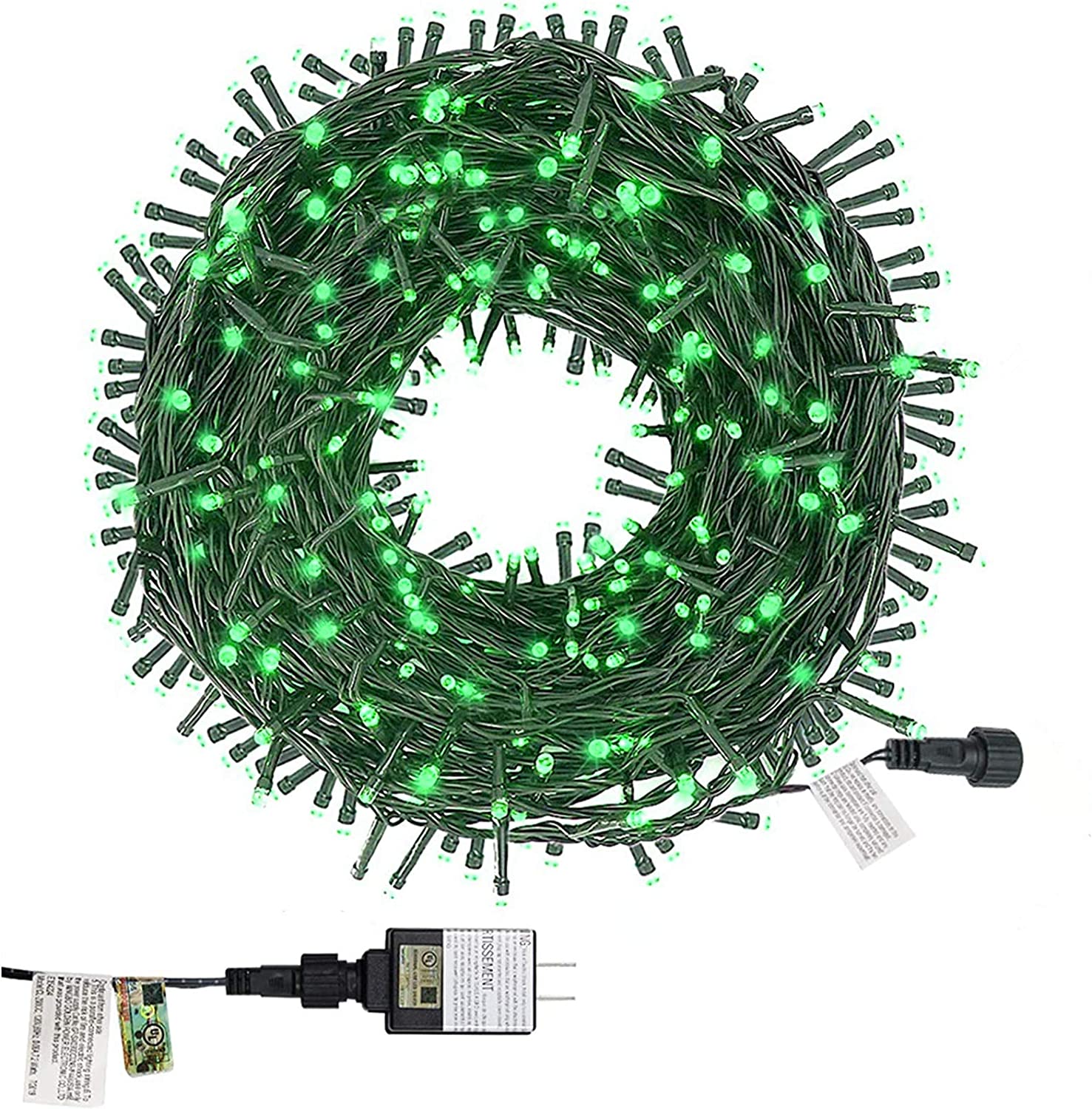
5. Green
Green is another traditional Christmas color. After all, Christmas trees are green, even during the winter months when most other trees have lost their leaves. Green Christmas lights can be used in combination with other colors (especially red) to create a fun and festive scene.
Best For: Tying together colorful holiday decorations.
Our Recommendation: Twinkle Star Green LED Christmas Tree String Lights on Amazon for $15.99
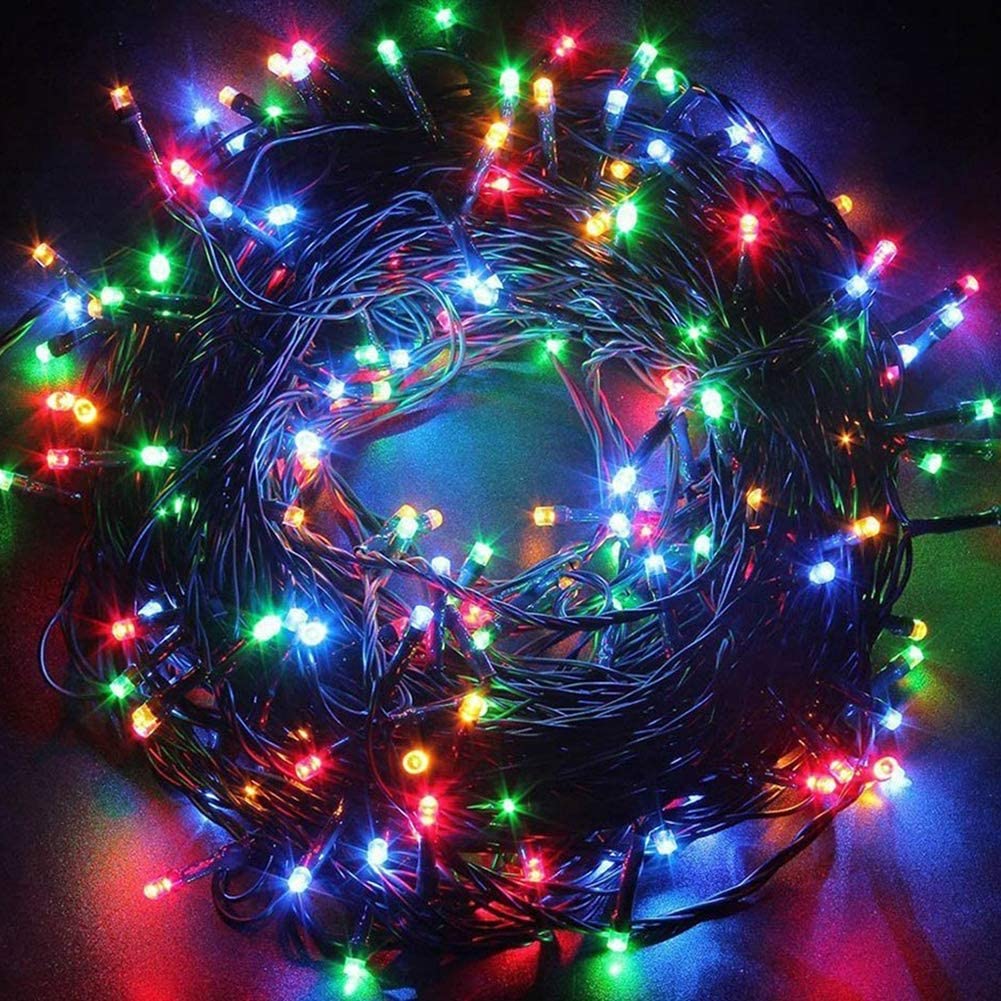
6. Multicolor
Multicolor Christmas lights are an ideal option if your aim is to create a bright and colorful display. Each strand of lights features a repeating pattern of colors—often some combination of red, green, blue, yellow, orange, and purple.
Best For: Creating a joyful and classic Christmas atmosphere.
Our Recommendation: Twinkle Star Multicolor LED Christmas Tree String Lights on Amazon for $17.99
Christmas Light Types
Whether you’re looking to hang lights along your home’s trim, illuminate trees or bushes, or add some stand-alone decorations to your landscape, there are a wide range of different Christmas light types to consider.
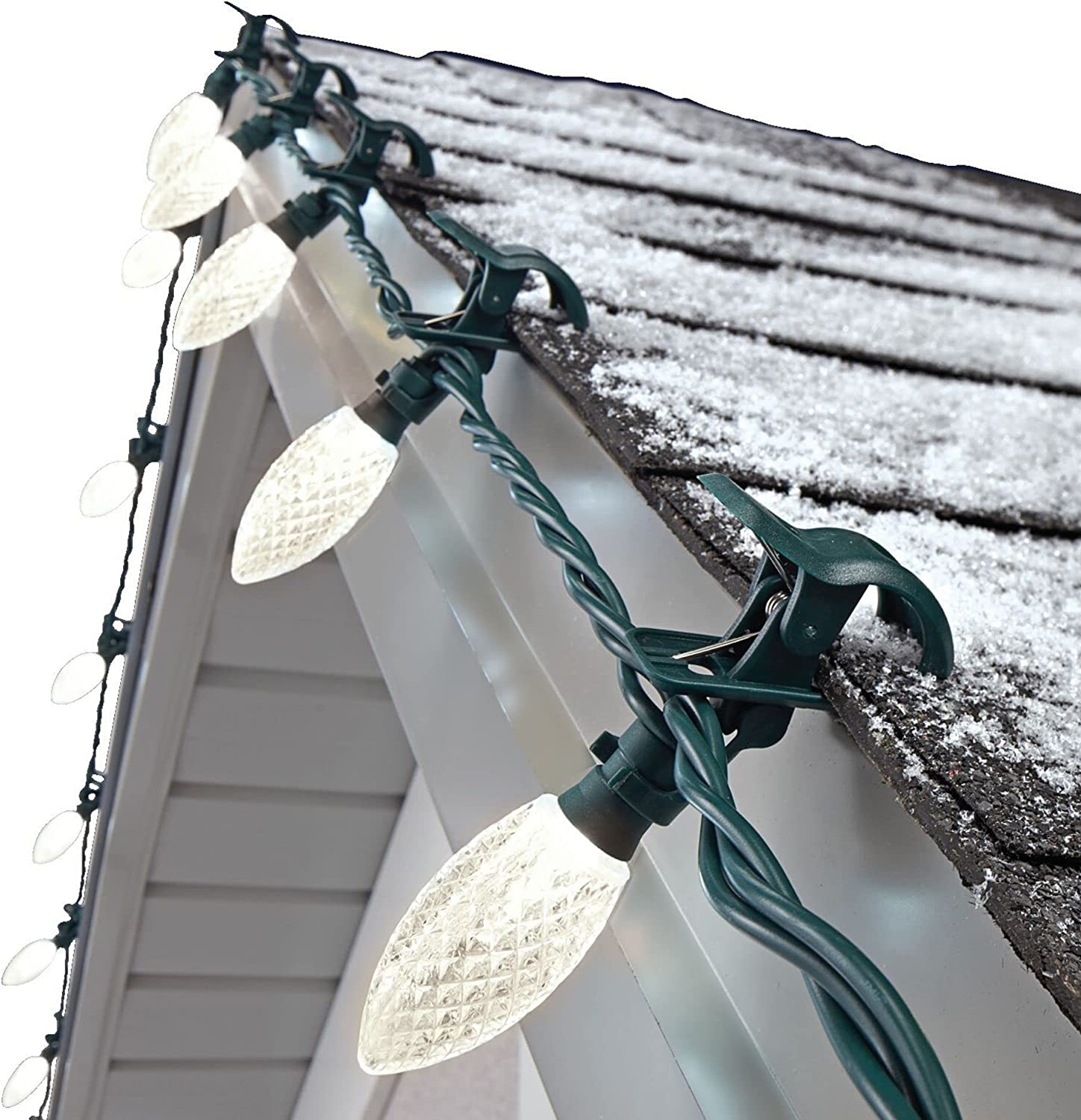
1. String Lights
String lights are the most popular choice for decorating Christmas trees, house exteriors, and much more. A string light consists of multiple bulbs on a wire or string. You can find string lights with the various bulb sizes shared above, including mini lights, C7, C9, and G12 bulbs. The string-like design of this type of light makes them a versatile decorating tool. Wrap string lights around shrubs or trees, hang them along the roofline of a home, or use them for creative accents indoors and out.
Best For: Decorating Christmas trees, landscaping, and a house roofline.
Our Recommendation: Noma C9 LED Quick Clip Christmas Lights on Amazon for $77.95
These outdoor string lights include built-in clips, making it easy to attach the bright C9 LED lights to a roof, branches, or railings.
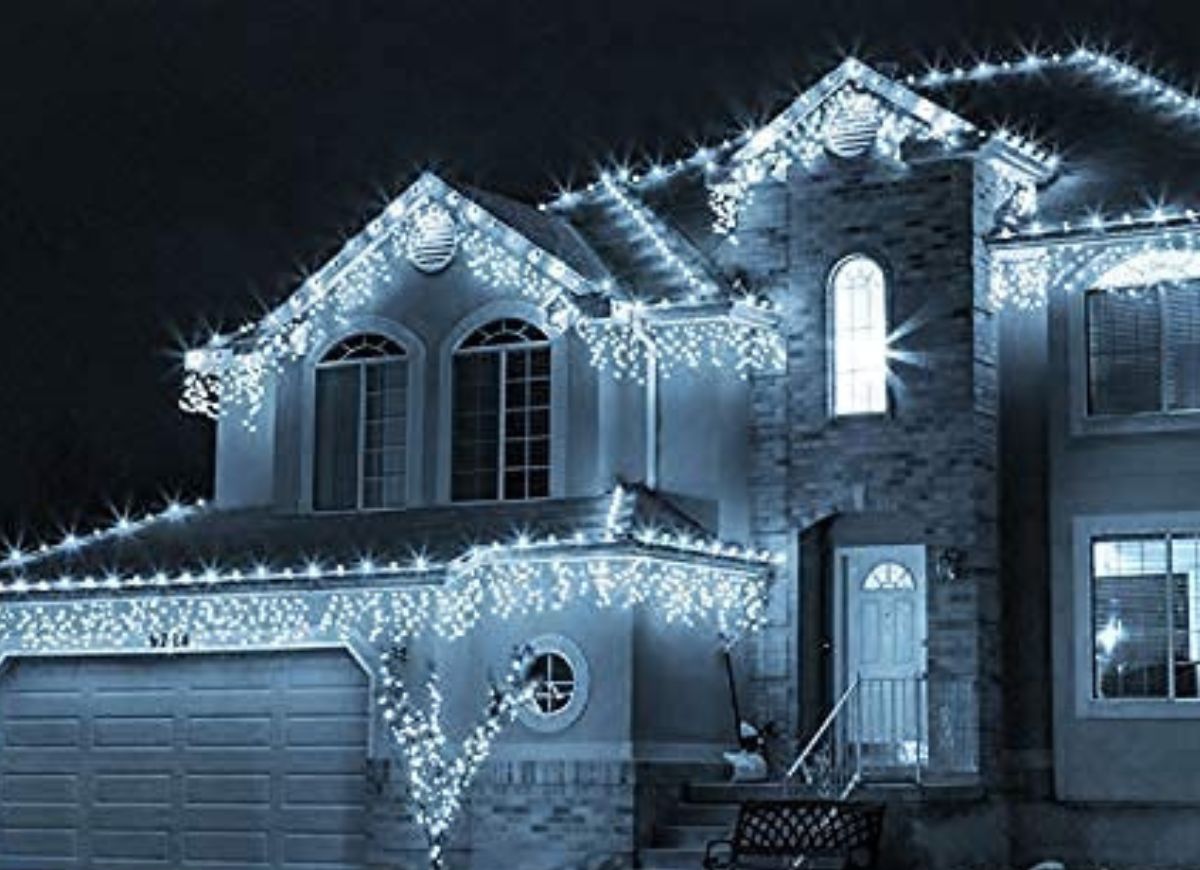
2. Icicles
True to the name, icicle Christmas lights mimic the look of icicles hanging from the roof. These seasonally inspired lights feature light strands in varying lengths that drop down from the longer string. Hanging icicle lights along a home’s gutter or eaves can make even a green Christmas feel more cozy.
Best For: Hanging along the roof for a snow-capped look.
Our Recommendation: Knoknew Christmas Icicle Lights on Amazon for $89.99
This 98-foot string of icicle lights features 228 vertical drops, eight modes, and a built-in timer.
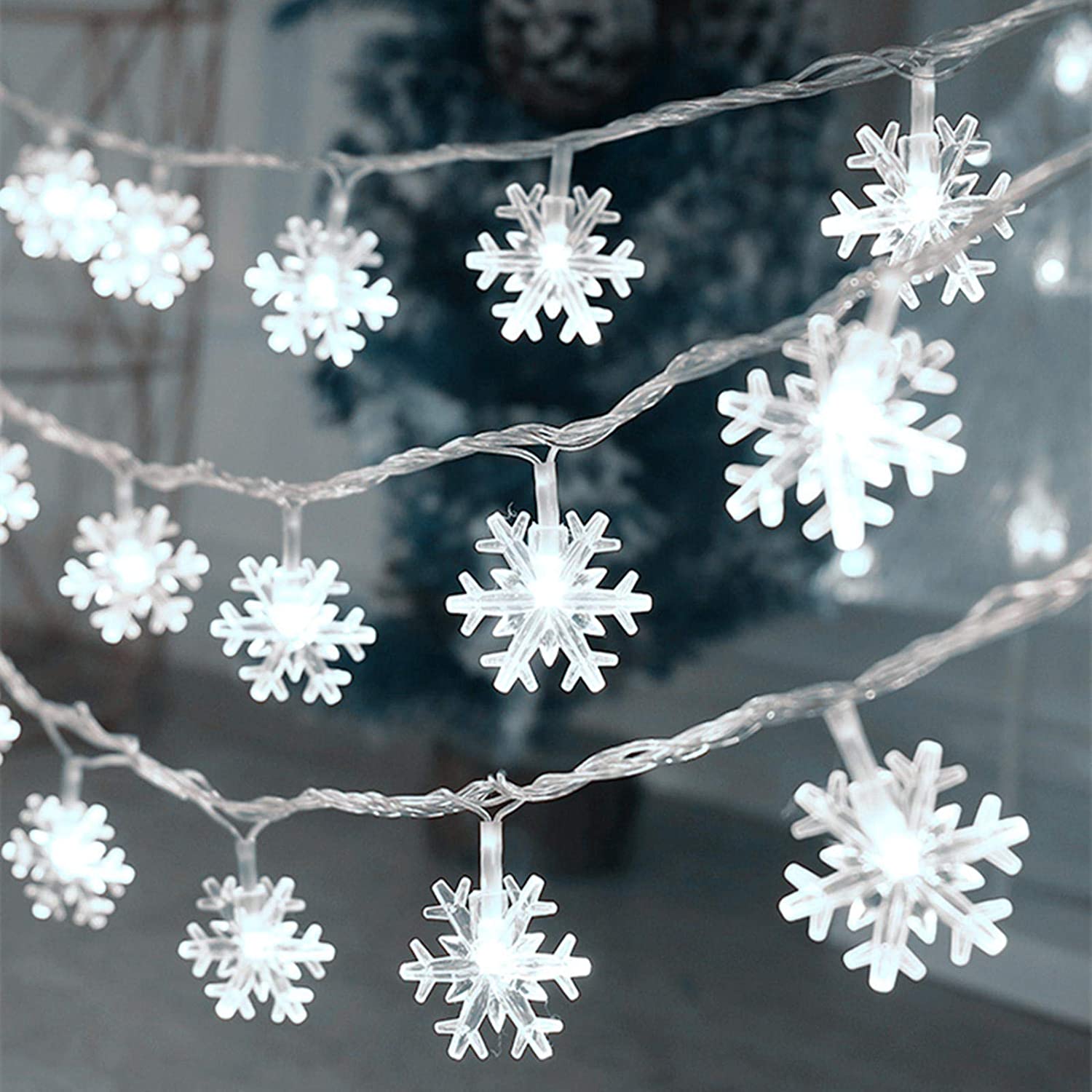
3. Shapes
There are a wide assortment of novelty string light shapes to bring more holiday cheer to your indoor or outdoor decorations. Novelty string light designs may include snowflakes, stars, Christmas trees, cylindrical icicles, and more.
Best For: Enhancing your interior or exterior with seasonal shapes.
Our Recommendation: Cesof Battery-Operated Snowflake String Lights on Amazon for $9.99
These battery-powered snowflake string lights add some wintry flair to any indoor area. Choose from steady-on or twinkle modes to match your decor and mood.
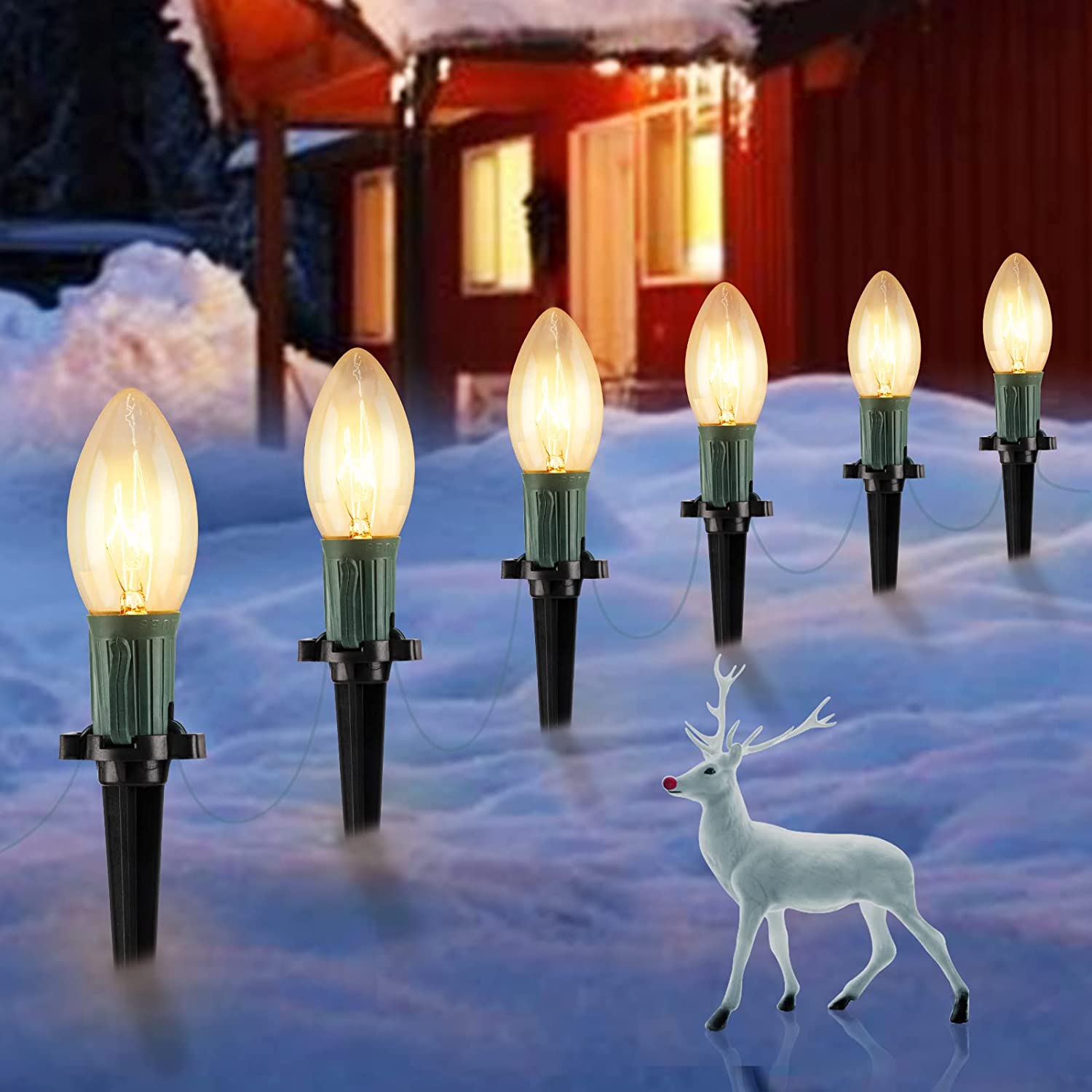
4. Pathway Lights
During the holiday season, consider switching out your regular solar path lights for Christmas pathway lights to enhance your outdoor holiday decor. Pathway lights are easy to install and come in multiple styles and colors to coordinate with different designs. Many pathway lights are solar-powered, eliminating the need for extension cords (though there are plug-in options).
Best For: Illuminating walkways and driveways.
Our Recommendation: Brightown Christmas Pathway String Lights on Amazon for $27.99
This string of 20 clear string lights comes with stakes for easy installation along walkways.
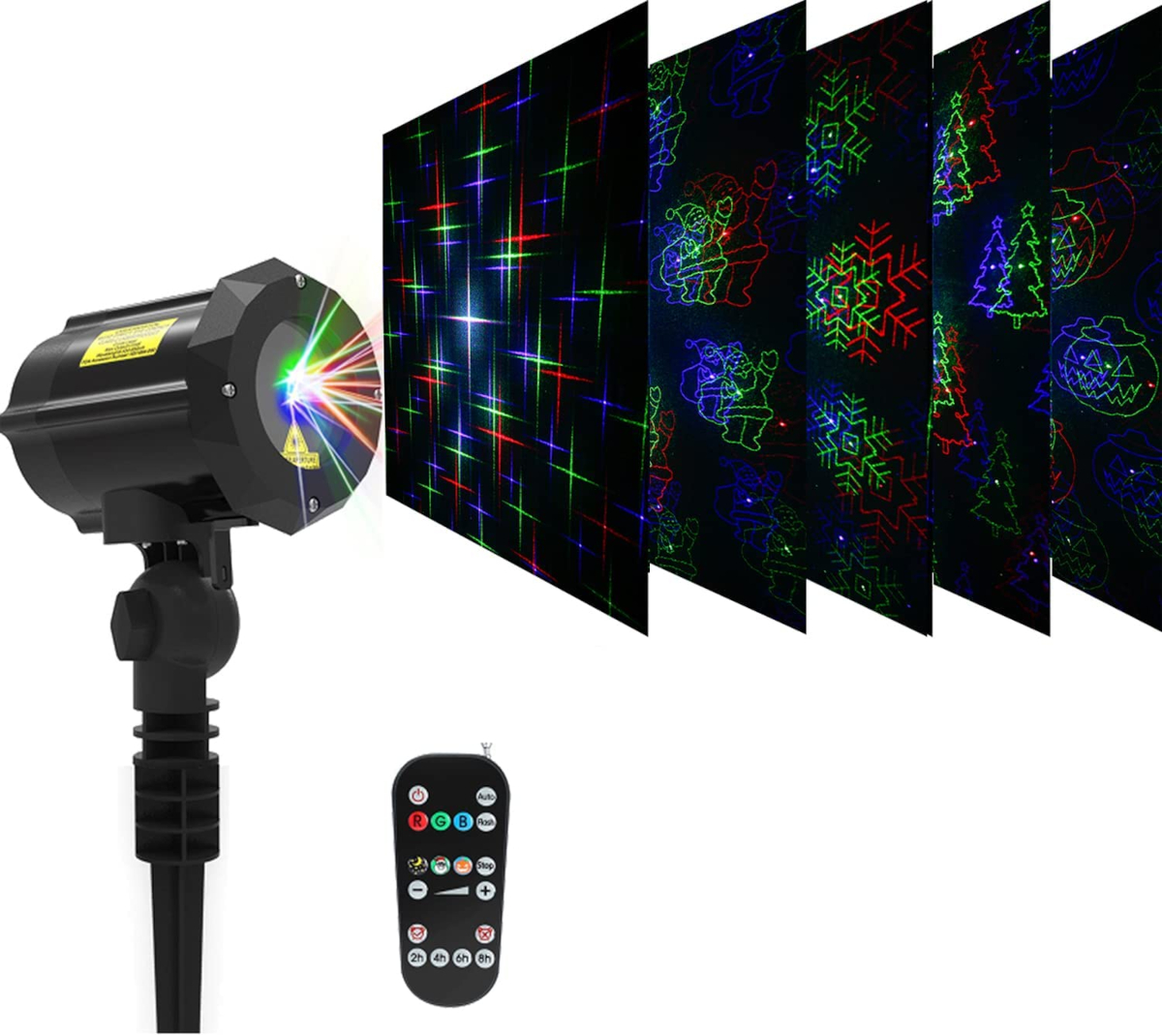
5. Projectors
If you’re unable or uninterested in hanging outdoor lights, or want to add an easy accent to your existing display, try a projector. Christmas projector lights are easy to set up—just stake it into the lawn, plug the projector into an outlet (or place it somewhere that receives plenty of sun for a solar projector), and point it at your house. Once turned on, you can adjust the light angle and direction and choose from a variety of colorful patterns to brighten up your exterior.
Best For: Easy-to-install lighted holiday decor accents.
Our Recommendation: LEDMall Motion Outdoor Laser Christmas Lights on Amazon for $115.71
With 18 moving holiday patterns, this decorative laser projector offers a simple and attractive solution for quickly lighting up a home for the holidays.
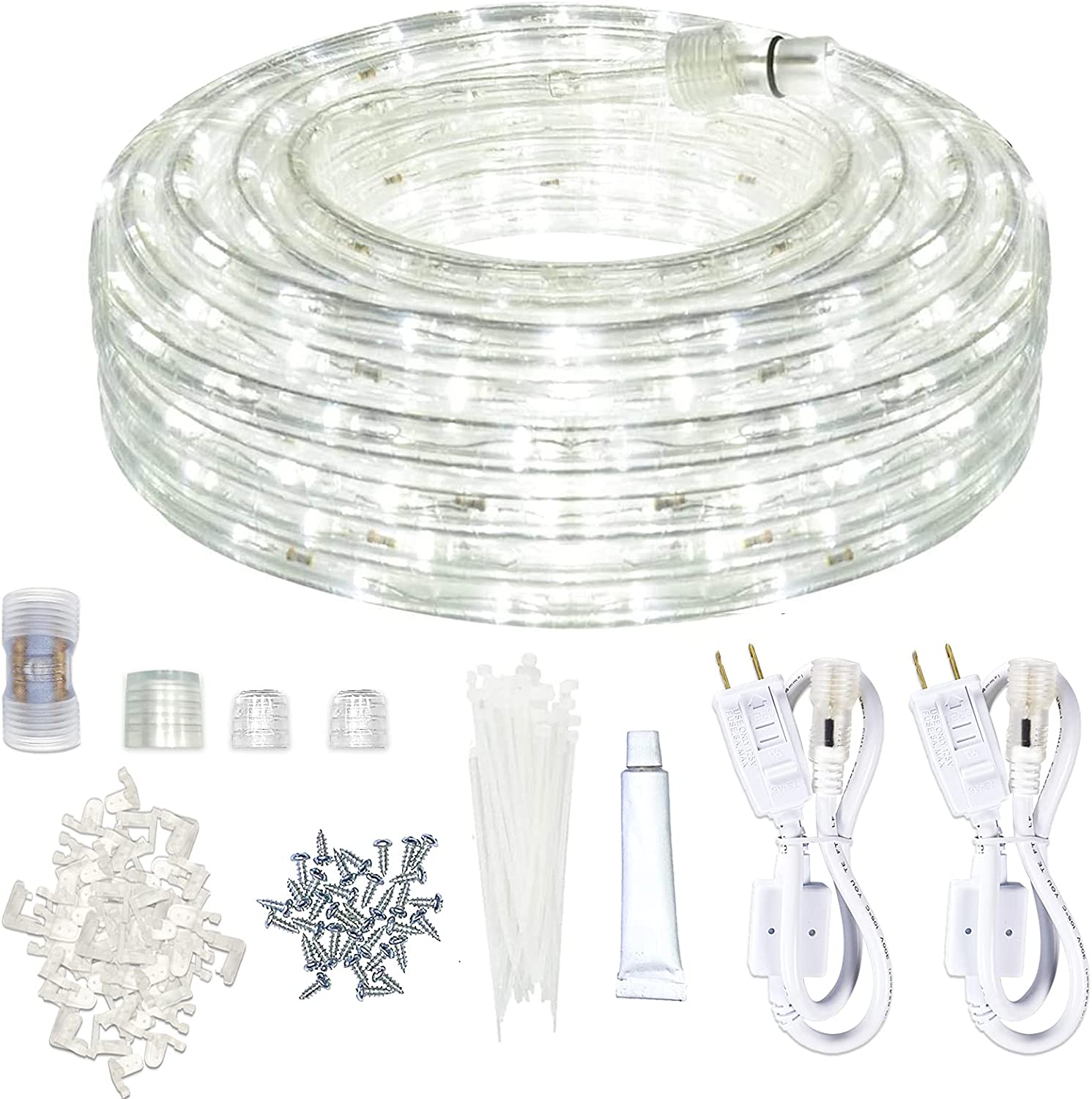
6. Rope Lights
Rope lights—tubes filled with internal lights—are commonly used to line doorways, windows, and cabinets year round, and they can add a nice touch to Christmas decorations in the winter. You can also twist rope lights into different shapes or connect them to frames to make unique and festive Christmas decor.
Best For: Outlining doors and windows.
Our Recommendation: Surnie Rope Lights on Amazon for $39.99
This rope light is 50 feet long and can be connected with other strands for longer designs. If desired, it can also be cut and covered to seal for smaller projects and designs.
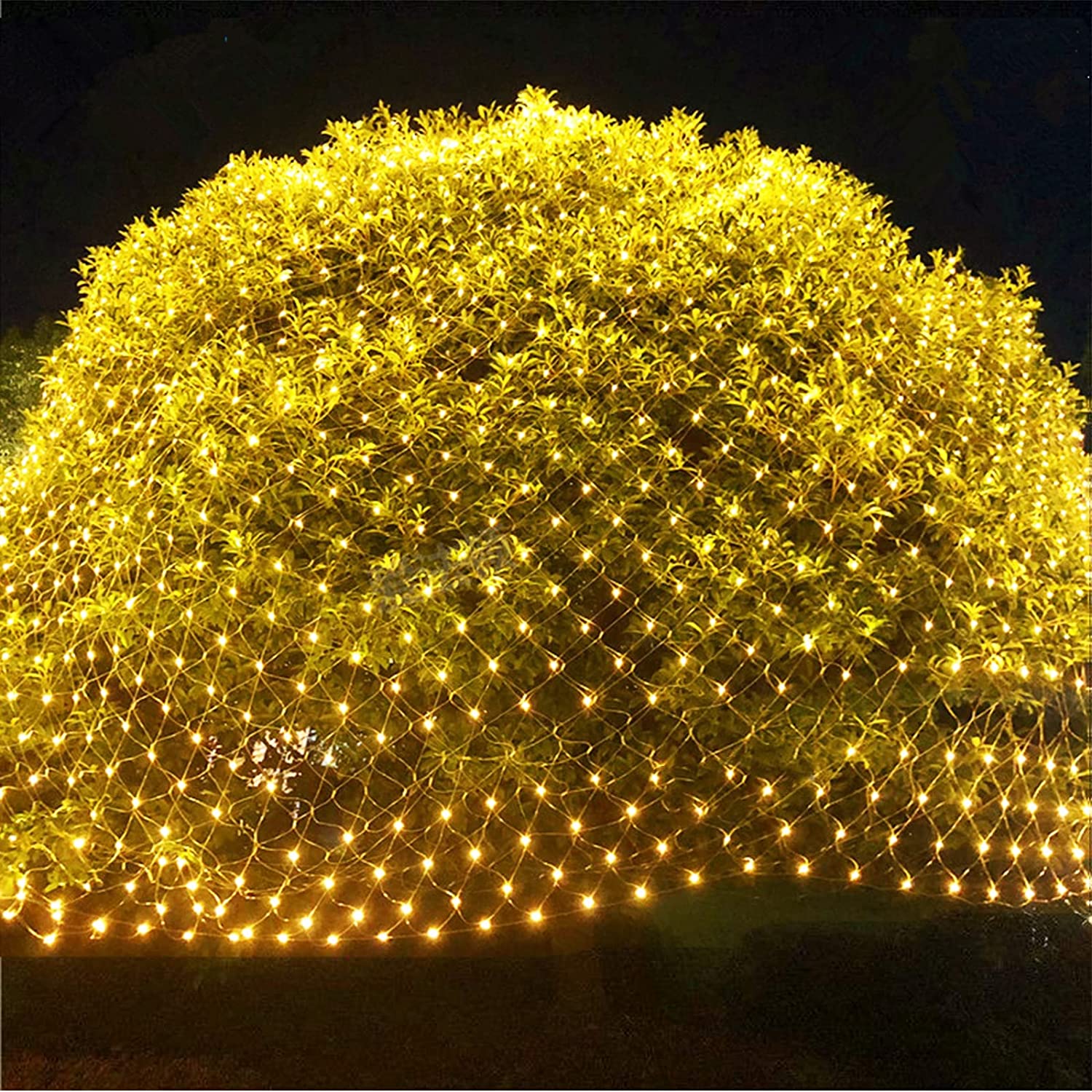
7. Net Lights
Net lights offer a quick and easy solution for decorating bushes and shrubs. They feature a grid design with multiple lights, allowing for a uniform look with minimal effort. Simply drape the net over a bush or structure and plug it in.
Best For: Highlighting shrubs and bushes.
Our Recommendation: Twinkle Star Christmas Net Lights on Amazon for $34.99
Sporting 300 LEDs, eight modes, and a timer function, these net lights are easy to install and offer a variety of effects.
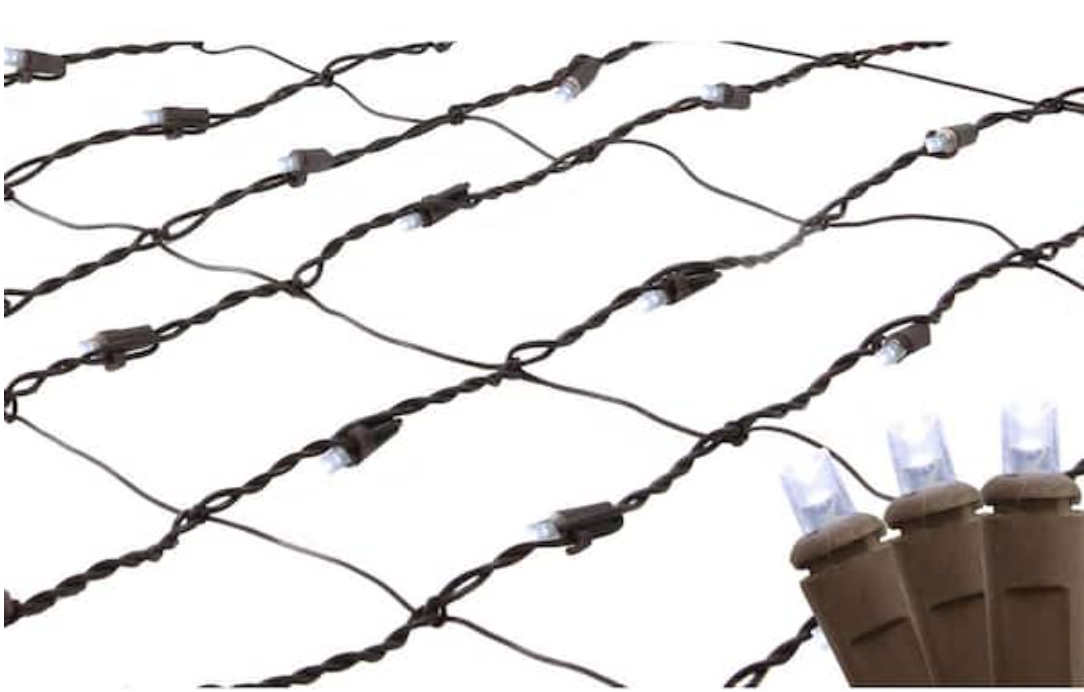
8. Trunk Wraps
Tree trunk wraps make it much easier to light the tall trees in your yard. Working similarly to net lights, these wraps stretch to fit tree trunks of varying diameters to illuminate trees and the space around them.
Best For: Wrapping around trees.
Our Recommendation: Northlight LED Net Style Tree Trunk Wrap Christmas Lights at The Home Depot for $32.73
These UL-listed tree trunk net lights offer 150 LED bulbs that cover 16 square feet.
The prices listed here are accurate as of publication on September 29, 2022.

